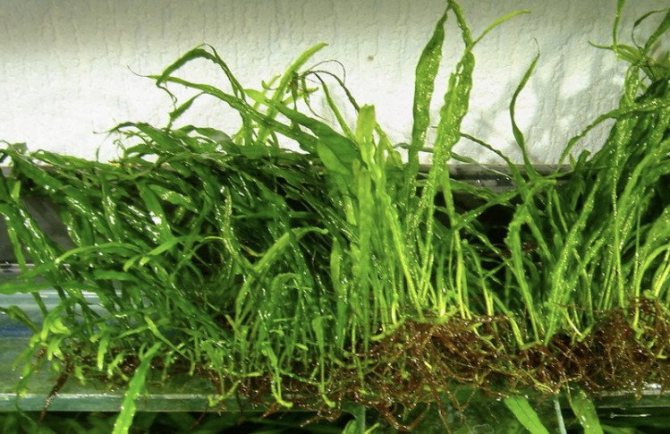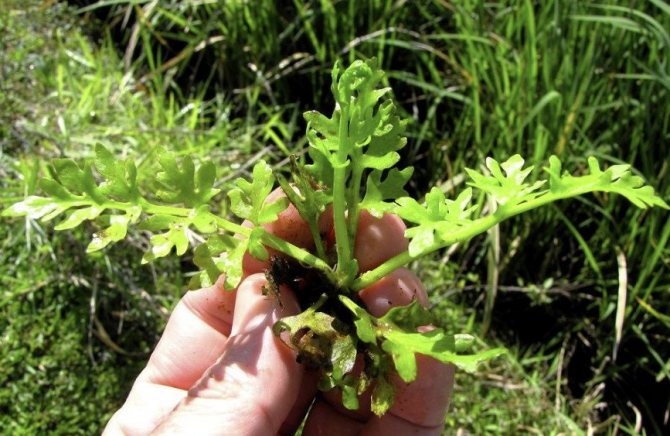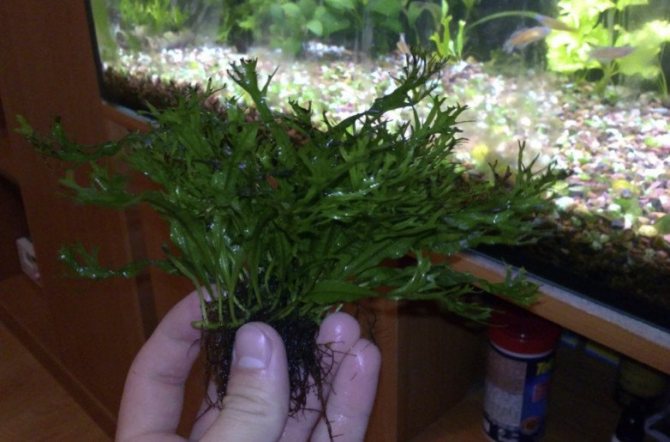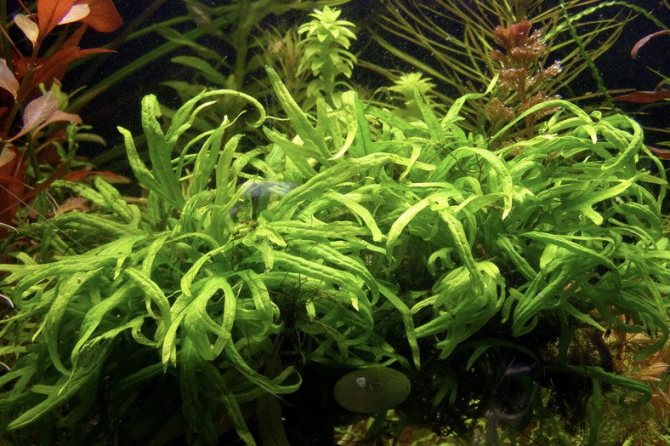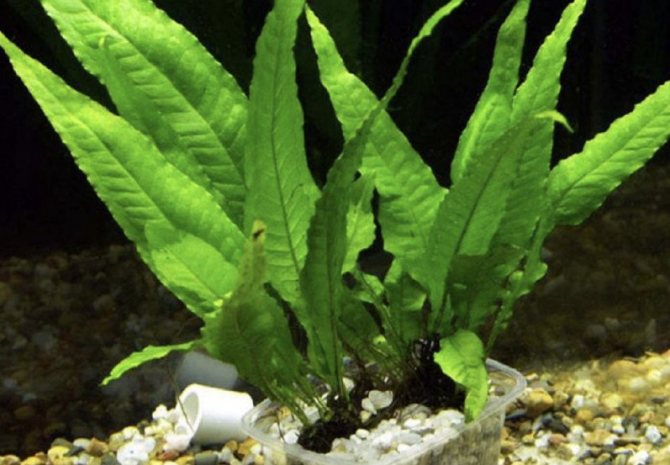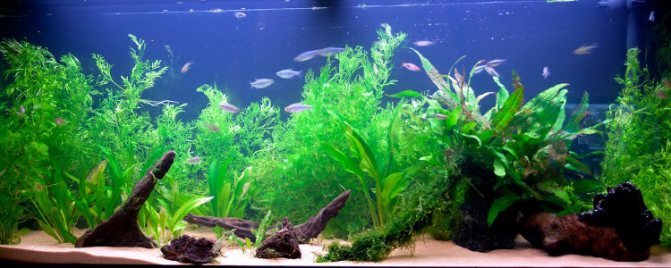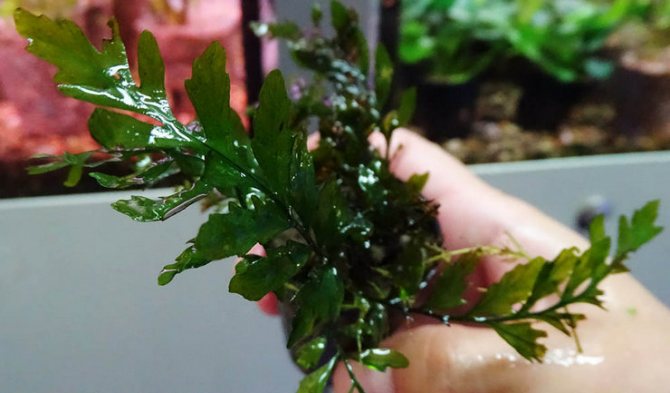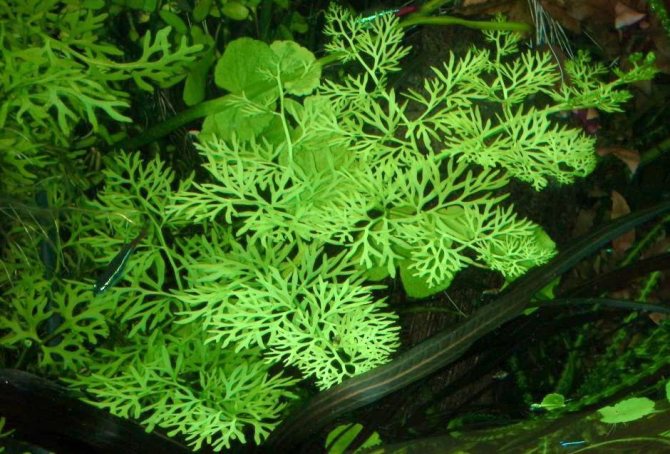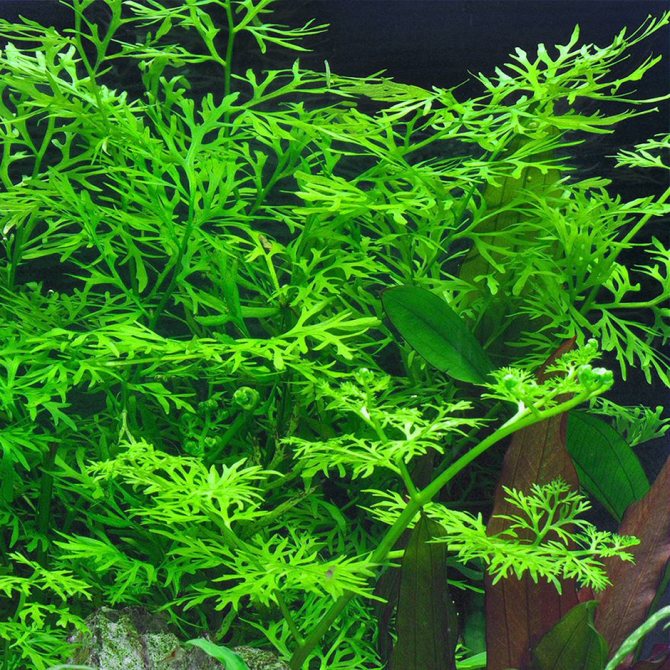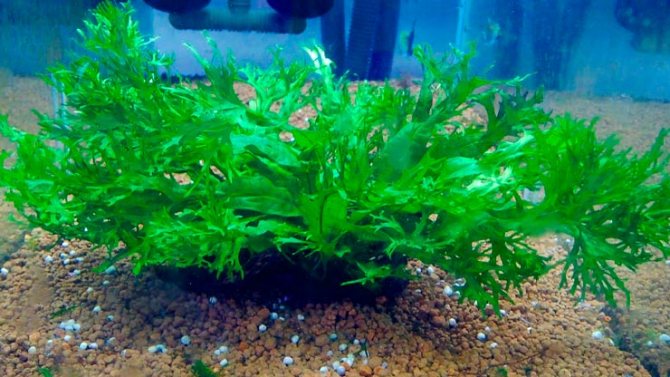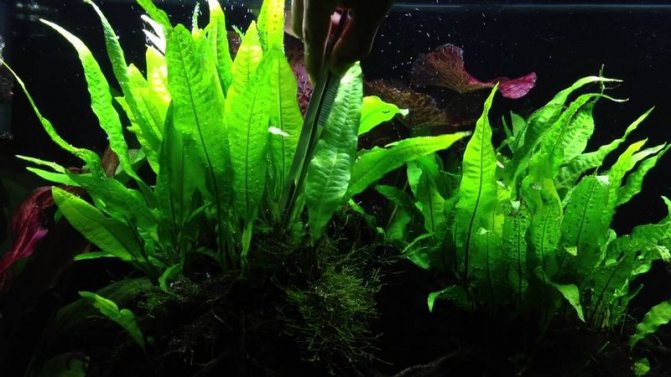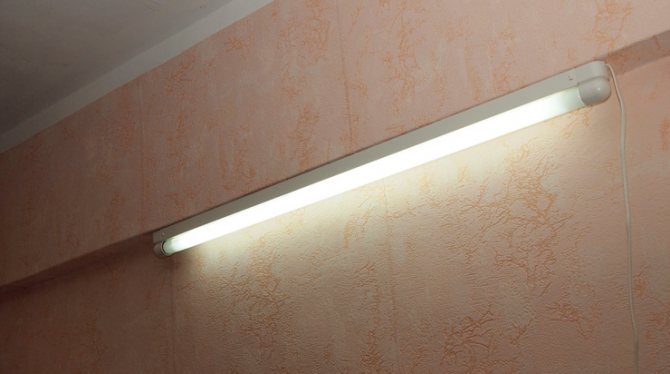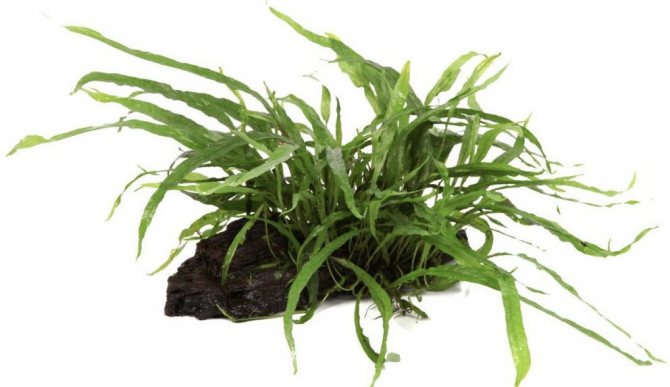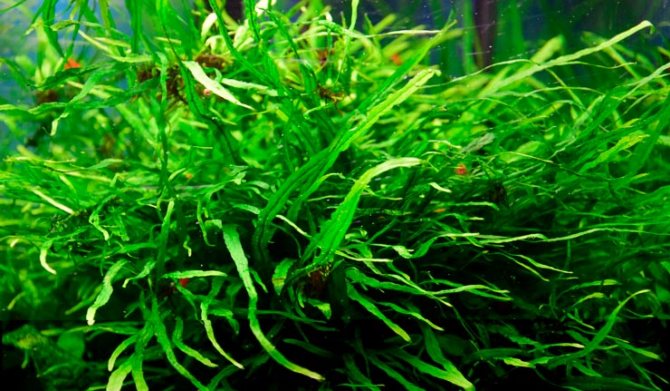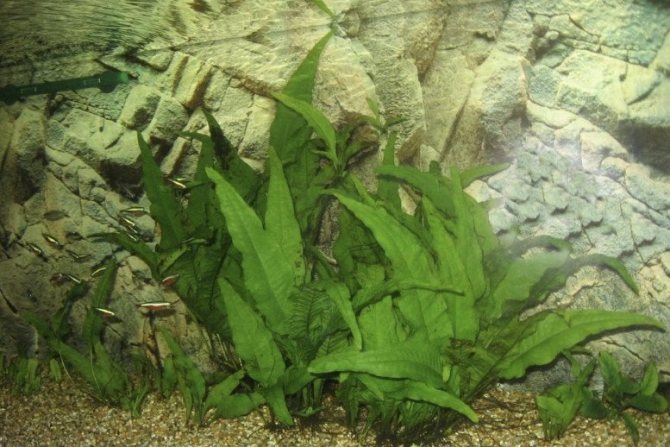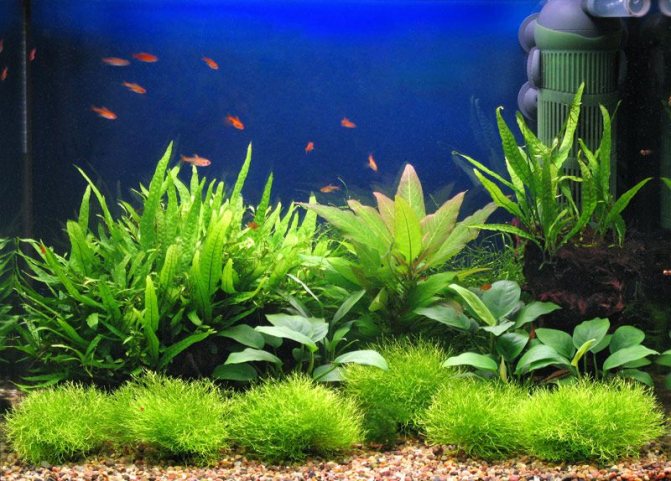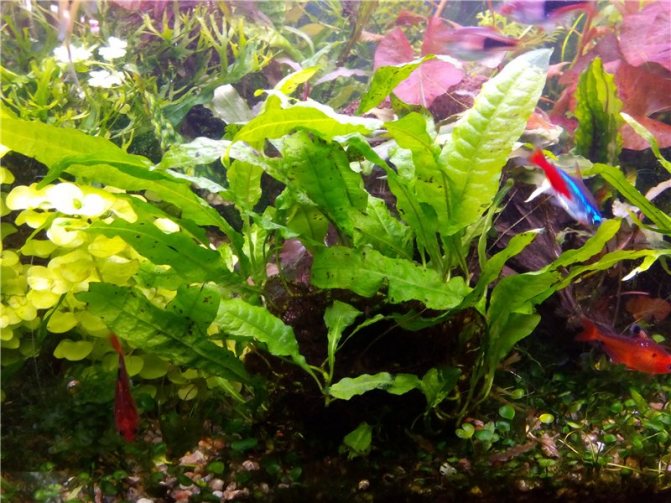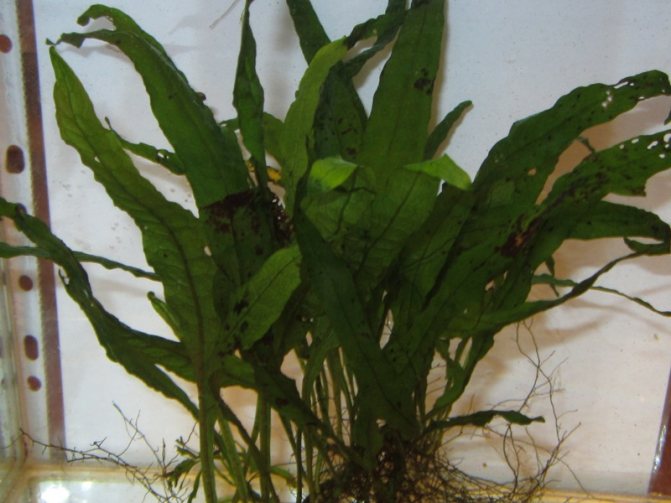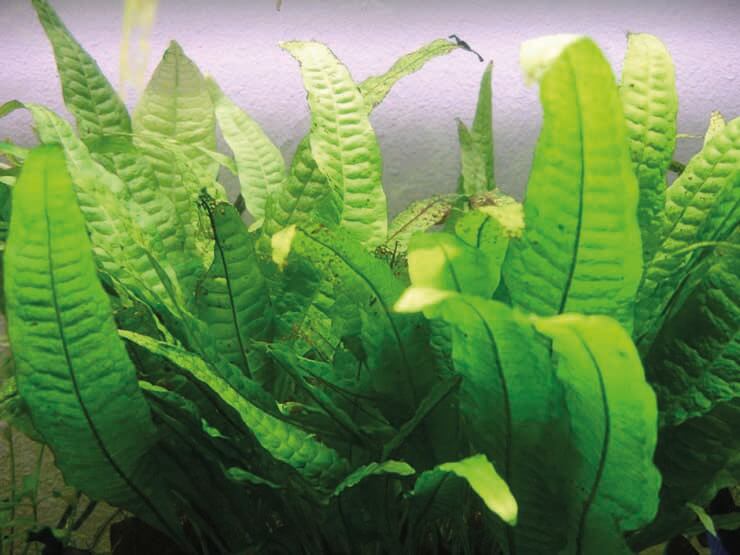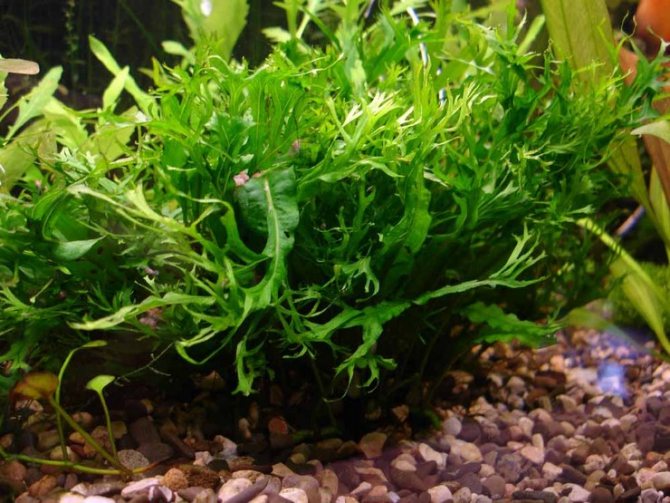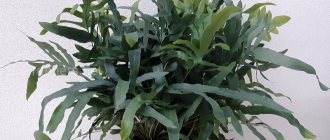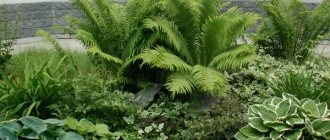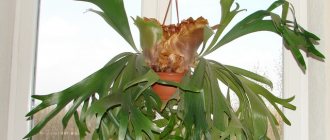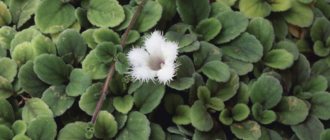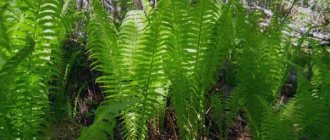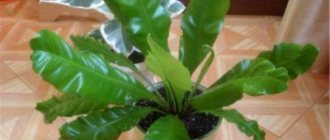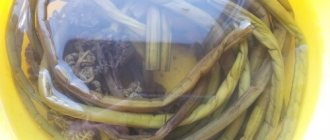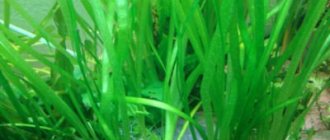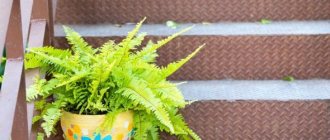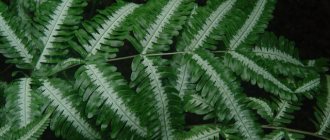The Thai fern, or, as it is also called, pterygoid, is one of the most popular varieties of aquarium evergreens. He is quite unpretentious in terms of maintenance and care. The Thai fern can be grown effortlessly even by novice aquarists. This plant will help you easily and efficiently decorate your home aquarium.
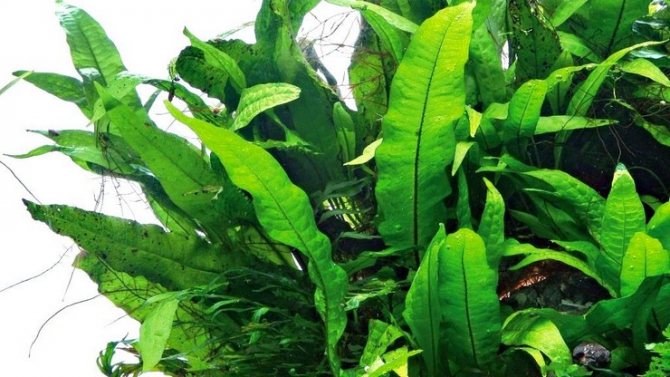
Thai fern can be a great decoration for your aquarium.
What does a narrow-leaved Thai fern look like?
Outwardly, the plant resembles a lush green bush, consisting of a large number of leaves. Each leaf is attached to a long, fleecy stem and is pulled out of it, as it were.
Microsorum Pteropus “Narrow” (this is the Latin name for the plant) can be of different sizes, depending on the conditions in the home pond.
- If there is little light, and carbon dioxide is not additionally supplied, then the leaf will not grow more than 10 cm in length and 5 mm in width. In addition, the color will become too dark.
- If light and nutrition are abundant, then the length of the leaf will increase to 15-20 cm, and the width to 10 mm.
Landing rules
Planting a fern in an aquarium is quite simple. As a rule, this plant develops rapidly on any soil without providing it with carbon dioxide, if it is artificially attached to some heavy object, for example, a stone or massive snag. Slow growth is considered a definite plus, since there is no need for frequent pruning of green spaces and the removal of unnecessary shoots.
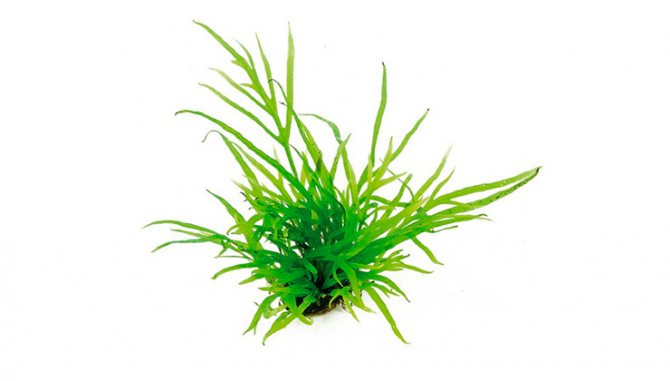

The Thai fern can grow without carbon dioxide, which allows it to take root in all conditions
To plant a Thai fern in your underwater world, you can use different methods. Any of them are good and easily applicable for both beginners and professional aquarists. Tools that can be used to decorate the aquarium at home:
- Fastening using a simple line.
- Fastening the fern to driftwood or stones using a nylon thread.
- The use of rubber harnesses. This type of attachment is the most reliable, but outwardly it will look unattractive in the aquarium.
- Quite often people use waterproof super-glue like "Moment" to fix the fern in the aquarium. However, in this case, you should not completely cover the plate with an adhesive; it should be applied only in a few drops in the necessary places. At the point of gluing, the roots will disappear, but by this time the plant will have time to grow and will sit firmly on the support.
Narrow-leaved microsorum in aquarium design
This fern is very compact. Perhaps this is what made it so popular in aquascaping. The plant can be used in both large and small aquariums. In the first case, it is planted in groups, and in the second, single bushes.
It should be placed in the background and in the center of the aquarium. The dark greens of the long leaves of the microorum will work great with the light leaves of other aquatic plants.
If you want to create an imitation of a dense forest in your home pond, then the narrow-leaved "Thai" is ideal for this.
Content
Microsorum Pteropus "Narrow" grows very well in warm water with a temperature of at least 24 ° C.With a decrease in temperature, its growth practically stops. In most regions of our country, water is not very suitable for keeping narrow-leaved fern, since its hardness is too high. The plant requires soft water, no more than 8 ° dGH, with a slightly acidic or neutral reaction (pH 5.5-7).
Frequent water changes are not only not required, but even contraindicated, since it somewhat slows down the growth of the fern. At the same time, a good water filtration system must be organized, since the presence of suspended particles in the water impairs the development of the plant.
Lighting from low to scattered bright, the Thai angustifolia fern is able to withstand prolonged shading. However, to obtain the most beautiful and largest bushes, bright lighting is needed, lasting about 12 hours.
Fern leaves remain green for a very long time under favorable conditions.
The fern is easily attached to driftwood and stones, using rhizoids for this. If the plant is planted in the ground, then for the first time, it is enough to press it with a stone. In no case should the rhizome be buried in the ground, otherwise it will start to rot.
The nature of the soil does not matter much, the rhizome grows over the surface of the soil. With small and thin roots (rhizoids), the plant is fixed to individual stones, due to which it is kept from moving.
It propagates like all Microsorum Pteropus vegetatively by dividing the rhizome, sometimes with the help of daughter plants formed on old leaves.
The Thai narrow-leaved fern is well suited as a substrate for spawning spawning fish.
Everyone HUGE Thank you for the likes:
Like
oformi-
Aquascape Promotion>
Fern thailand
has a wide variety of species that differ from each other in the shape of the leaf. em> The Vindelova Thai fern has a leaf dissected at the end. There is a Thai trident leaf fern (Microsorum pteropus 'Trident'). But this article will talk about the narrow-leaved Thai fern, which, as the name implies, differs from the usual Thai fern in a narrower and longer leaf. The leaf length of the narrow-leaved fern can be up to 15 cm, and the width is no more than 1 cm. The Thai narrow-leaved fern varies greatly in size depending on the conditions in the aquarium. The more food and light there is in the aquarium, the larger its size. In aquariums without carbon dioxide supply and with low light, the leaf length of the narrow-leaved fern usually does not exceed 10 cm and the width is 5 mm. And in such conditions, it has a darker green color. Like all ferns, the Thai fern grows easily on driftwood and rocks.
In aquascaping, the narrow-leaved fern is especially popular. By themselves, Thai ferns have a special place in the design of plant aquariums, as they give the aquarium a special and unique aura of a deep forest. Aqua designers even single out fern aquariums in a separate category, in which the share of ferns among other plants is 80% or more. These aquascapes have their own characteristics of care that are different from other plant aquariums with the same planting density of aquarium plants. As a rule, in such aquariums the lighting level does not exceed 0.5 watt / l, they are supplied with minimal doses of aquarium fertilizers and often do not supply carbon dioxide. The popularity of the narrow-leaved Thai fern is due to its compactness. It can be used in the design of both large and small aquariums.
Thai ferns are undemanding to keeping conditions, but prefer soft, acidic water. It is enough to maintain a minimum CO2 concentration of 5 mg / l in order to obtain lush green thickets of the plant.
Externally, Microsorum Pteropus "Narrow" looks like a bush of many leaves that stretch out on long stems. It turns out that these stems, on which the leaves are attached, are the root system. These stems are covered with small villi. The entire root system can be attached to the ground stones and thus grow. To promote plant growth, there must be a high level of silt in the soil, which is considered a good nutrient, and not only for this fern species.
Growth features
The narrow-leaved Thailand fern differs from the normal Thailand fern in a narrower and longer leaf. The length of the leaf of the narrow-leaved fern can reach 12-15 cm, and the width is 6-10 mm. The leaf size of the Narrow-leaved Fern depends on the conditions in the aquarium. The more food and light there is in the aquarium, the larger its size. In aquariums without carbon dioxide supply and with low light, the leaf length of the narrow-leaved fern usually does not exceed 10 cm and the width is 5 mm. And in such conditions, it has a darker green color. Like all ferns, the Thai fern grows easily on driftwood and rocks.
Microsorum Pteropus "Narrow" grows very well in warm water with a temperature of at least 24 ° C. With a decrease in temperature, its growth practically stops. The plant requires medium hardness or soft water, 8-12 ° dGH, with a slightly acidic or neutral reaction (pH 5.5-7). Microsorium does not need frequent water changes, but a good water filtration system must be organized, since the presence of suspended particles in the water impairs the development of the plant.
Lighting from low to scattered bright, the Thai angustifolia fern is able to withstand prolonged shading. To get beautiful and vibrant leaves, you need to provide bright light. But even in medium light, the plant feels normal. For Microzorium, 8-10 hours of light is enough for its development to be optimal. If all the conditions are met and the plant has adapted, then a beautiful fern with bright green leaves will grow in the aquarium.
Periodically, young leaves appear on the plant, and in this way you can get new cuttings of Microzorium. If you notice black dots on the bottom of the leaves, do not be alarmed. These are such disputes. The young Microzorium, together with the old leaf, separates from the main plant and rises to the upper layers of the water. There it takes on a root system and after that its weight contributes to the fall of the entire bush to the bottom. If you divide a large plant into bushes with a small number of leaves, then you can already get several new ferns.
Application in aquarium design
Narrow-leaved fern is especially popular in Aquascaping due to its compact size. It is an attractive plant suitable for small aquariums too. Used to decorate the middle and background of the aquarium. Its dark green, long leaves blend wonderfully with the light leaves of other aquatic plants. In small aquariums, the bush can act as a large single plant, but in large aquariums, it is best planted in groups.
To the size of the aquarium, Microzorium Narrow-leaved is also not whimsical. It could also be a very small aquarium. It looks best if you plant the plant around the perimeter and in the center. If the area of the aquarium is too small, it is not worth planting a lot of microsorium. In small quantities, it will look more impressive. But in the case of large aquariums, it can be planted in groups of several plants at once. Microzorium can play an important role in the design of your aquarium.
We create optimal conditions
The Thai narrow-leaved fern is considered an undemanding plant. Let's note what you need to pay attention to.
Water should be soft (no more than 6-8 degrees) and sour (5.5-8).Too hard water leads to the formation of "wounds" on the leaves - black spots. The permissible range of values for a temperature is 18-30, however, 24 degrees is considered optimal. In colder water, this fern slows down or stops growing. Microsorum can also be kept in brackish aquariums.
Equipment... Frequent water changes are unacceptable, as they negatively affect growth. But good filtration, but without a strong current, is necessary.
To obtain lush thickets, an additional supply of carbon dioxide in the amount of 3-5 mg / l is required.
Lighting. Narrow-leaved microsorum can adapt to various illumination, both low and diffuse bright, and even long-term shading. But if you want to get large, beautiful bushes, then it is better to install bright enough lamps. The recommended daylight hours are 12 hours.
Soil type unimportant, since the rhizome does not grow in depth, but along its surface, firmly attached by rhizoids to snags and stones.
Compatibility. You need to pick up fish that are not too active and do not dig the soil. The fern doesn't like all of the above, and it stops growing.
Fern indian water-aquarium plant.


The water parameters for the content should be as follows: water hardness up to 6 °, with a slightly acidic reaction, for this, pieces of boiled peat are added to the filter. Water temperature 22-26 ° С. When the temperature drops below 20 ° C, the plant may die
Lighting, very bright, not less than 0.5-0.7 W / l, it is possible to illuminate the aquarium, both with fluorescent lamps and incandescent lamps, when sunlight hits the aquarium, the light must be scattered, direct rays will cause algae fouling of the leaves.
The soil, the root system of the plant is quite well developed, but at the same time the roots are very fragile. Therefore, fine soil, well silted, but not sour, is suitable for planting.
Appearance
The leaves of the plant are small, dissected, of light green tones. The height of the fern stalk can reach 50 cm. Thin stalks extend from the rhizome of the plant. Leaves are attached to these stalks. The Indian fern grows in the ground, and can float on the surface.
Conditions of detention
Artificial lighting or natural lighting does not matter. The main thing is that it is powerful. For fluorescent lamps, 0.4-0.5 watts should be used for 1 liter of water. The plant will need to be shaded from the sun's rays. A day at the Indian fern lasts 12 hours. Despite the fact that the roots of the plant are well developed, they themselves are very fragile and brittle. When planting a fern in the ground, be extremely careful. Coarse sand is good for the substrate. It is desirable that the soil is silted, but not sour. Lay the sand 4-5 cm. You should not additionally feed the plant, since the fern is sensitive to the presence of nitrates and nitrites in the water. Water and soil provide the plant with all the nutrients it needs.
Since the fern is an Indian thermophilic plant, a tropical aquarium will be just right for it. Temperature suitable for ferns is 22-26 degrees. If the leaves of the plant suddenly become smaller, and growth has slowed down, it means that the temperature in your aquarium is below normal. Hardness not higher than 6 degrees. Alkaline, hard water is not suitable for the plant.
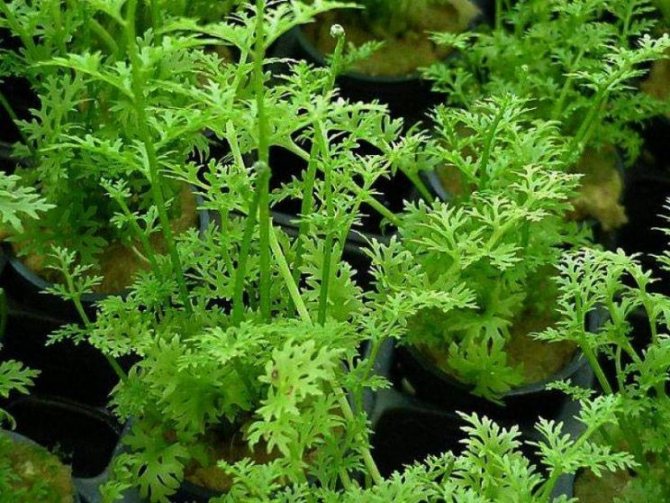

The acidic environment must be neutral, and a weakly acidic reaction can be tolerated. You can put pieces of boiled peat in the filter. The water fern does not need frequent water changes. Water saturated with humic acids satisfies the plant. Indian fern serves as a light filter, protects neighboring plants from algae growth. In addition, it acts as a kind of assimilator, the water where the plant grows is always impeccably clean. It is better to plant the fern one at a time, closer to the center of the aquarium.
Breeding
The propagation of the Indian fern is carried out by daughter plants.When root lobes and a couple of leaves appear on the mother bush, the daughter plant independently separates and floats to the surface. Floating in the thickness, it continues to grow like a normal plant. A shoot with roots can also be placed in the ground.
Reproduction of the Thai narrow-leaved fern
It is vegetative and can occur in two scenarios:
- By dividing the rhizome. In this case, a large bush is carefully divided into several small ones. Further, the resulting bushes are planted in the planned places.
- Daughter plants, periodically forming on old leaves. They separate from the main plant along with the old leaf and float to the surface of the water. They drift there for some time until a root system is formed. After that, they get heavy and fall to the bottom.
Description of the genus "Ceratopteris"
Department of flowering, or Angiosperms (MAGNOLIOPHYTA), or (ANGIOSPERMAE) Family: corneous (Ceratopteridaceae)
Grows in warm areas.
Fern, rooting in the ground or floating on the surface of the water, with a shortened stem and a rosette of petioled leaves.
Propagated by daughter plants formed from the adventitious buds of the leaf, which separate and float to the surface of the water.
Other species of the genus:
- Floating Fern or Water Cabbage (Ceratopteris cornuta)
Maintenance and care
Thai ferns are very easy to care for and, unlike most other aquarium plants, do not need soil and will grow well without CO2 supply. These plants cannot be buried in the ground, but they can be tied to stones and snags. Just tie a fern bush to a small rock to make it heavier, and you can place the plant anywhere in the aquarium. In addition, all varieties of Thai fern are a wonderful decoration, they look especially good with snags, therefore they are often used in creating a natural aqua design. This plant is also especially loved by aquascapers because of the slow growth of the plants - they do not have to be cut and trimmed often.
In order to tie the plant to a stone or driftwood, you can use fishing line, dark silk thread, or glue the plant with super glue. Some people use rubber bands, but they are more visible and look ugly.
Thai ferns do not need special lighting and can be damaged if the light is too intense. Even an ordinary incandescent lamp is suitable for them, but it is better to choose a fluorescent lamp with low brightness white light. To determine that the lighting is too strong, you can look at the fern leaves: if they turn brown and transparent, then you need to reduce the lighting, and then the ferns will recover.
The only thing to remember when growing Thai ferns is the regular supply of fertilizers. These plants do not have "true" roots, they get most of their fertilizer from the water. If you want your plants to grow really beautiful, be sure to add liquid fertilizer after every weekly water change. Tableted fertilizers that are placed under the roots of plants are useless for the Thai fern - they will not be able to use them, since they do not have a root system.
Several types of Thai fern can be found on sale.
Thai narrow-leaved (Microsorum pteropus "Narrow K")
A very interesting form of aquatic fern used to create landscapes of incredible beauty. Unpretentious look. It has become widespread among amateur aquarists relatively recently. Average price.
Thai narrow-leaved (Microsorum pteropus "Narrow")
The rhizome of this species reaches 10-15 cm in length, the leaves grow up to 10-20 cm. Suitable for small aquariums. It is very often used in designs with snags, it looks just wonderful with them!
Microsorum pteropus "Undulata"
This species is much softer and more tender than other species. The leaves are light green in color, wavy, more reminiscent of Aponogeton in shape. A very rare species of Thai fern, not often found on sale, but you can buy it if you wish, the price, respectively, is higher than that of other species.
Pterygoid Filipino (Microsorum pteropus "Philippine")
Narrow, graceful leaves - this type of Thai fern has only recently gained popularity. This plant does not feel well in soft and acidic water, which is not surprising, because in nature it lives in slightly brackish waters. Under unsuitable water conditions, holes and black areas appear on the leaves of the plant. Suitable parameters for the content: hardness 10 dGH and pH not less than 6.6. This plant is an excellent candidate for salt water maintenance. Just like other fern species, it requires little light and CO2. It grows faster than other species, the leaves sometimes reach a length of 40 cm.
Thai fern or pterygoid-aquarium plant
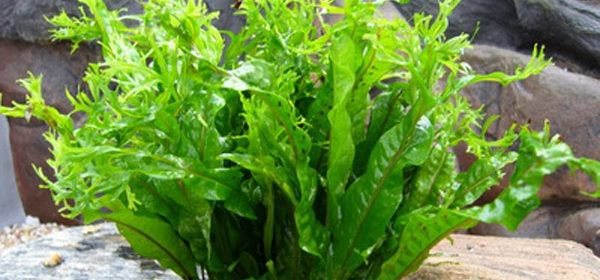

Lighting can be strong or moderate... The fern withstands long-term shade, but grows well only with sufficient light. Natural, diffused light has a positive effect on plant development. Incandescent and fluorescent lamps can be used as artificial light sources. The power of the illuminators is selected individually, depending on the needs of neighboring plants and the characteristics of the aquarium. Daylight hours should be approximately 12 hours.
Soil for Thai fern is not required... Its rhizome is always located on top of the ground, and the root system is relatively poorly developed, for it the silt accumulated at the bottom is quite enough. Therefore, in an aquarium with soil, the nature of the substrate particles does not matter.
Conditions of detention
Feels comfortable fern thailand in a tropical aquarium with a water temperature of 24 ° C. Even under optimal conditions, it grows slowly. And at temperatures below this, growth practically stops. According to the parameters of reaction and hardness, the water can be any, for the pterygoid fern this does not matter. However, soft, slightly acidic or neutral water with hardness indicators not higher than 6 ° will become optimal.
These conditions are usually formed in old water, and therefore it is not recommended to make frequent changes. The plant most easily tolerates changes of 1 / 5-1 / 6 of the total volume of the aquarium water no more than once or twice a month. Moderate or strong lighting is required to keep the Thai fern. Withstands shading for a long time, but its growth is disturbed.
Naturally diffused light is of course most beneficial. Sources of artificial lighting can be both incandescent and fluorescent lamps, the power of which is individually selected for each aquarium, taking into account the needs of neighboring plants. Daylight hours should be at least 12 hours. The rhizome of the pterygoid fern is poorly developed and, as a rule, is located above the ground.
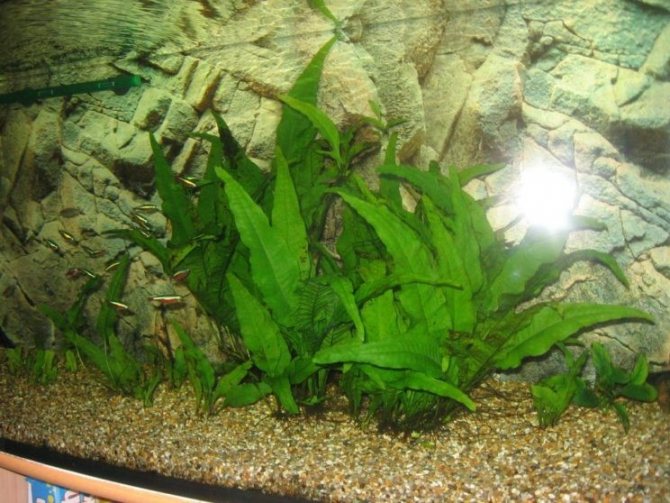

Therefore, the nature of the substrate, as well as its presence, is completely irrelevant. For such a root system, the silt that has accumulated on the bottom of the aquarium is quite enough. To improve the growth performance of the fern, it is recommended to periodically, about 1-2 times a month, make mineral fertilizing.
Also, special attention should be paid to the addition of nitrogen fertilizers and trace elements, the doses of which should be minimized. From a number of nitrogen fertilizers, urea is most suitable, adding 1-2 granules per 100 liters of water two to three times a week. The plant is hard to tolerate anxiety.
Mineral dressing added to the water improves fern growth... Particular attention should be paid to the addition of trace elements and nitrogen fertilizers.For the pterygoid fern, the minimum doses of microelements added to the water 1-2 times a month are quite enough. Of nitrogen fertilizers, it is best to use urea 2-3 times a week, 1-2 granules per 100 liters of water.
In the aquarium, Thai fern reproduces only vegetatively... The rhizome of the plant is divided into parts with 2-3 leaves. A new plant is formed from each part. This fern species has another method of vegetative propagation: on the edges of old decaying leaves, growth buds form, from which young plants develop.
After the death of the old leaf, daughter plants break off and float to the surface. A floating young plant gradually develops a rhizome, under the weight of which it sinks to the ground.
When growing a Thai fern, it must be borne in mind that it absolutely does not tolerate anxiety and the presence of suspended organic particles in the water... In the aquarium where it grows, it is necessary to transplant plants and catch fish as rarely as possible. Intensive aquarium purging, strong water flow and the presence of fish digging in the aquarium significantly impair the growth of this fern.
Family of Centipede or Polypodiaceae.Aquarium plants of this family are represented by terrestrial or epiphytic ferns. The rhizome of these representatives can be creeping or erect, thick or thin, naked or scaly.
Leaves, as a rule, are alternate, but can be found collected in bunches. Leaves are herbaceous, thin, evergreen and hibernating. In young plants, the leaf blades are coiled, and in adults, they are pubescent or glabrous from pinnate to simple.
Spore-bearing leaves of these aquarium plants from vegetative ones may not differ or differ in shape and size. Small, collected in sori, sporangia are located on the underside or along the edges of the leaflet. They can be with or without bedspreads. Plants can be used to decorate an aquarium or a humid greenhouse. The centipede family is cultivated in these places by several species, mainly marsh.
Fern Thai pterygoid or Microsoriumpteropus (Blume) Ching.
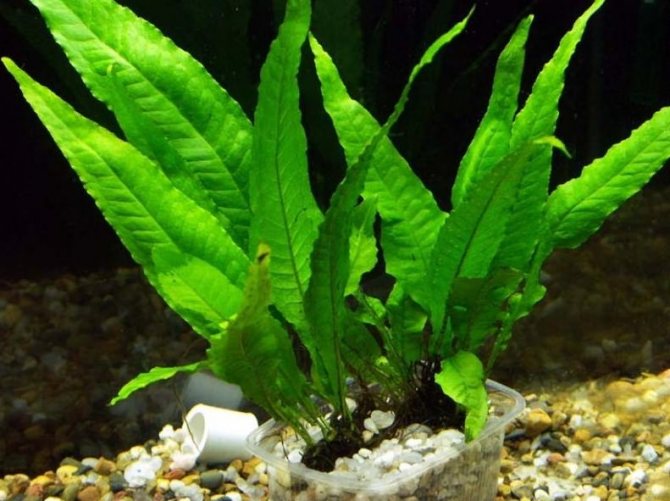

These aquarium plants are often found naturally in the tropical part of Southeast Asia (from Indonesia to India). In natural conditions, it grows up to 45 cm in height. The plants grown for the aquarium are of course much smaller in height. The rhizome is formed very branched, rigid, creeping.
Usually colored dark green. From the rhizome, successive single leaves stretch vertically upward. The adventitious roots are covered with small villi and have a dark brown color. The leaves are arranged on small petioles, hard to the touch, lanceolate, simple, bright green in color.
Fern breeds
very easily, by baby cuttings that form on old leaves at the top. It can also be propagated by spores that appear on the underside of the leaf or along the edges, in rare cases, on the adventitious roots. Good growth and reproduction requires soft water and full immersion. These aquarium plants float along the surface of the water.
If it is necessary to lower it to the bottom, the cuttings are heated. The property of the root system of the Thai fern to attach to the pebbles of the soil, which are at the bottom of the aquarium. It is recommended to put pieces of boiled sour peat under the roots of the plant.
Compatibility
The peculiarity of the Thai fern is that very few species of fish will want to mess with it - even fish that are constantly trying to eat any aquatic plants. Perhaps this aquarium plant will not last long in the vicinity of goldfish, but it can get along well with large cichlids and many herbivorous fish.Some say this is due to the bitter taste of their leaves, although other sources claim that it is the tough structure of the leaves that makes them unattractive to fish. In any case, this is a rare chance to decorate an aquarium with plant-eating fish and even some species of turtles with live plants.
The Thai fern is a very popular aquarium culture. In many respects, its wide distribution is due to its unpretentiousness and excellent adaptability. The plant grows well, does not need fertilizers, does not need additional lighting, perfectly coexists with different aquarium inhabitants. The Thai fern looks very nice. Its size, shape and color of leaf plates may differ depending on the variety of the plant itself.
general description
The fern is also called Javanese. In its natural habitat, this plant can be found in Southeast Asia. In nature, the fern can grow up to 50 cm in length. However, when grown at home in an aquarium, this green pet only grows up to 30 cm. This is because the plant does not have enough natural light, and it is under artificial lamps throughout the year.
There are several different varieties of Thai fern, which differ from each other in the shape of the leaves and their size. The most common types are:
- narrow-leaved;
- with needle-like leaves;
- windel;
- lanceolate.
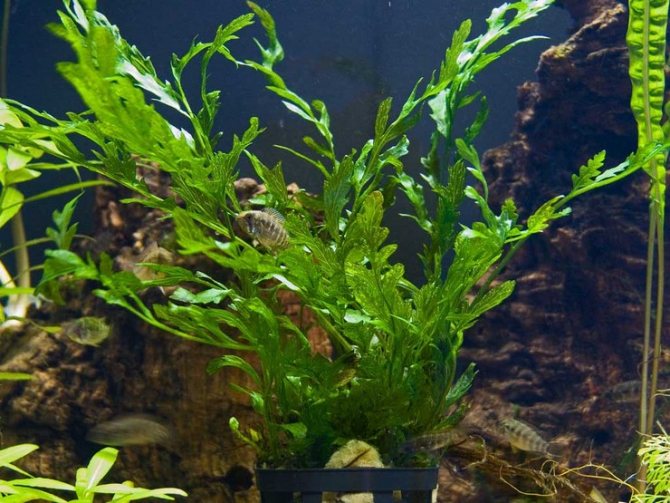

The appearance and size of the Thai fern may vary by geographic location
In nature, plants prefer to settle on a rocky bottom, covered with silt, on large snags. The culture clings to various supports with the help of its rhizoids, which are threadlike formations. On the leaves of this aquatic culture, spores are clearly visible, which become much darker during the ripening period. The leaves have an elongated lanceolate shape, constantly stretching to the surface of the water. The leaf plates are quite bright, have a juicy green tint. If all the necessary growing rules are observed at home, then the aquatic culture can grow into bushy and dense thickets.
In an aquarium, it can be planted both in groups and individually in the form of an unusual bush. The Thai fern in an aquarium is quite easy to grow as it does not require CO2 or strong lighting or additional fertilization.
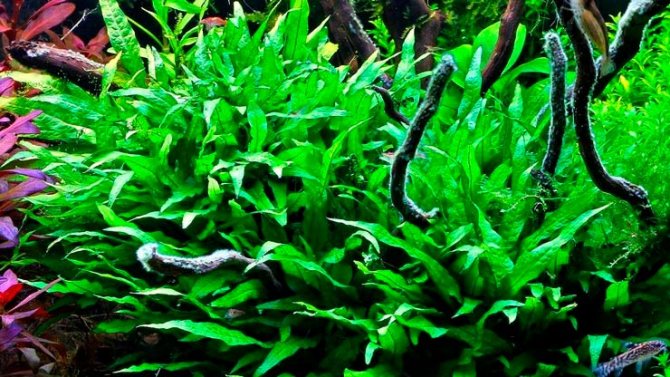

Thai fern is not whimsical to the environment
Habitat and appearance characteristics
A Thai fern native to Asia. Belongs to the millipede family. It can grow both on land and in water. An attractive aquarium culture that forms dense thickets. No special requirements for soil, lighting, free space.
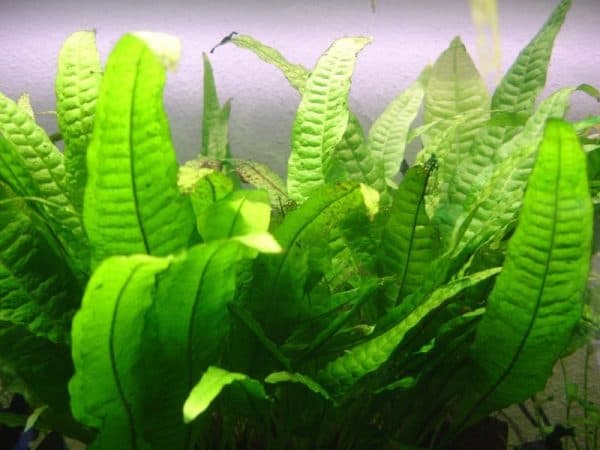

The foliage of the Thai fern has a bright green color, growing rapidly, forms a beautiful, dense shrub. The average height is about 20-25 cm.
It develops evenly throughout the whole year. Perfect for decorating and decorating any type of artificial reservoir. The culture propagates in a vegetative way.
Decorating a small aquarium with ferns
The water landscape in a home aquarium requires a special approach and imagination from its creator. You can buy ornamental fish and an expensive tank, equip the container with the necessary devices, but if the design is poor, all the work will be in vain, and your water world will look poor and unkempt. The Thai fern helps to build any composition of decorative objects and stones in a short time, turning even small reservoirs into green gardens.
This ornamental plant forms a graceful rosette of leaves, but in general it takes up little space inside.The presence of the beautiful Microsorum pteropus instantly revives an artificial ridge of stones or a lonely snag. Aquarium water fern is great for creating an underwater alley. A frame of the desired shape and size is constructed, and prepared rhizomes of the seedlings are attached to it with fishing line or other material. After a couple of months, you get a decorative hedge of bright green leaves.
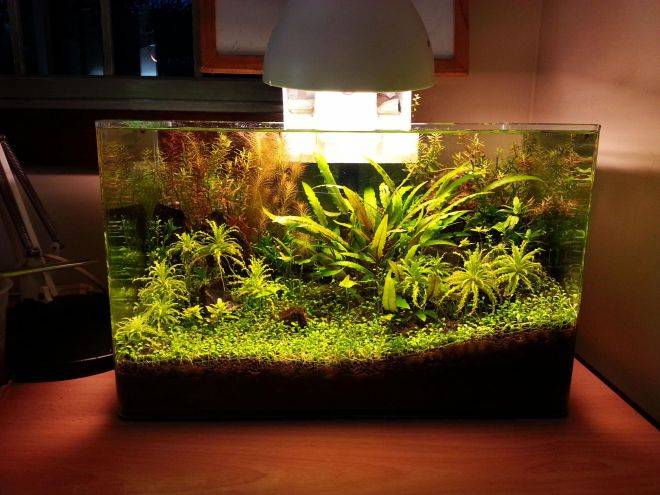

Conditions of detention
The Thai fern can be safely attributed to the category of the most picky, unpretentious aquarium cultures. This plant has no need for soil.
It is strictly forbidden to bury seedlings in the ground, but they will perfectly feel tied to snags and underwater pebbles. For these purposes, thick threads and fishing lines, which aquarists prefer to use due to their inconspicuousness in the water, are perfect.
The slower growth rates make the fern a suitable decoration for even small aquariums. In addition, this feature eliminates the need for aquarium owners to regularly thin out and trim the tops of the plant.
Thai fern does not need too bright light, it tolerates shading well. But excessively intense illumination, on the contrary, can harm it, provoke damage, thinning and darkening of the leaf blades.
It is recommended to use weak fluorescent lamps for additional lighting.
Daylight hours should last at least 12 hours, only in this case you can count on the formation of a beautiful, healthy shrub with bright, eye-catching foliage.
Since the plant receives most of the microelements and nutrients from water, it will respond perfectly to additional liquid fertilizers. It is recommended to apply top dressing regularly after cleaning the reservoir and changing the water. It is important to use the liquid form of fertilizer, tablet preparations for the Thai fern will be useless, due to the lack of rhizomes.
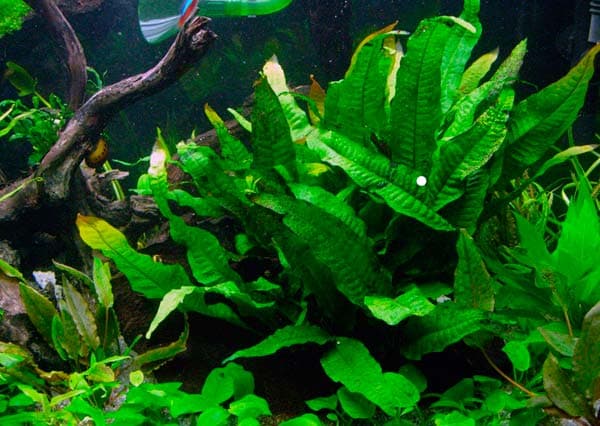

Fern in the aquarium - care
There are several criteria that strongly influence the successful growth and development of this underwater organism - the temperature of the environment, its chemical indicators, soil quality, lighting. The Thai fern in the aquarium can be kept at home by beginners who have recently begun to master the art of keeping exotic fish, but in order to successfully complete this task, they need to learn the basic rules for caring for the amazing Microsorum pteropus plant.
The main conditions for good growth and reproduction of the Thai fern:
- Chemical composition of water. The liquid should be used with hardness values within 6dH with acidity parameters 5.5-7 pH. Old aquarium water has similar characteristics in many cases, for this reason it is often not necessary to change the medium. A partial replacement of 20% of the liquid in the container is enough every 14 days.
- Water temperature. The Thai fern does not tolerate cool water well. A decrease in temperature to 18 ° C leads to a cessation of the growth of leaves and roots, therefore the best conditions for Microsorum pteropus are considered to be an aquatic environment at 24 ° C.
- Lighting quality. If you dream of getting a powerful plant with bright exotic leaves in the aquarium, then it is advisable to maintain a daylight hours for it for 12 hours.
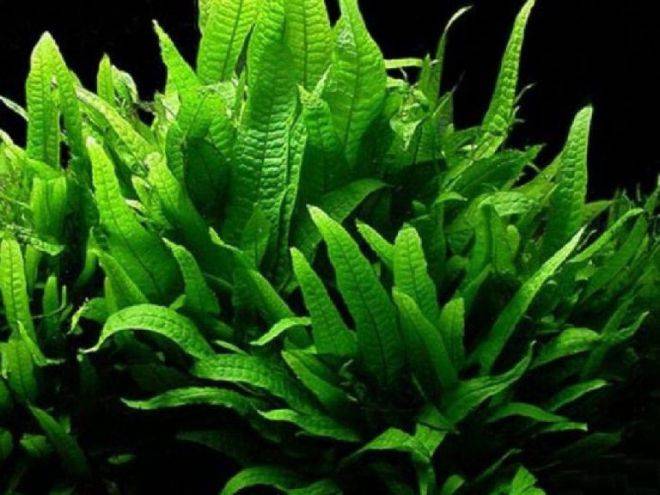

What problems can arise
Thai fern - hardy and stress-resistant. The main problem that aquarists face when growing a plant is growth retardation due to deficiencies in nutrients and valuable micronutrients. This can be avoided by timely application of liquid fertilizers.
In addition, it is necessary to monitor the acidity indicators of the aquatic environment, since with a strong increase in it, the fern leaves begin to blacken and deteriorate.Bottom fish, when excavating soil, can damage and injure the weak roots of an aquatic plant, preventing its growth and reproduction, so it would be better to refuse such a neighborhood.
Indian fern
The places of natural growth of this species are tropical zones on continents and islands. Aquarists hold the Indian water fern in high esteem, and masters of the underwater landscape also very successfully use it to create their masterpieces.
Keeping Indian ferns in the aquarium
This plant shows its decorative qualities and incredibly fast growth to the full with proper maintenance. It is impossible to say that this is a difficult and demanding care, but you will have to adhere to certain rules. Successfully growing a fern in an aquarium is impossible without the following steps:
- Since the plant is a guest from the tropics, then in the conditions of the aquarium it will be necessary to maximize the basic parameters. In particular, this applies to temperature. It should be within 22-26 ° C. When it decreases, the fern grows in the aquarium poorly, and the leaves themselves become noticeably smaller and the decorative effect is noticeably reduced.
- Be sure to monitor the reaction of water: if it approaches hard alkaline, the plant withers. Ideally, the reaction should be neutral, slightly acidic is allowed.
- A fern needs good quality lighting in an aquarium. A combination of natural and artificial light is allowed. The latter is quite successfully provided with fluorescent lamps and even incandescent lamps. Your task is to provide the plant with 12 hours of daylight hours.
- The Indian fern does not just do without feeding, but even withers away from their excess. He especially does not tolerate excess nitrates and nitrites.
But care is greatly simplified by the plant's indifference to changing water. Some plants need constant replacement or partial replacement. This plant does not require such actions and grows quite well in old water, if it contains humic acids.
>
>
What is useful
The Thai fern is characterized by the following beneficial qualities that make it popular among aquarists:
- creating a beautiful aquarium design, without undue effort;
- the release of a large amount of oxygen;
- the formation of bushy thickets, extremely comfortable for rest, games and breeding of small fish, fry;
- water purification, filtering function.
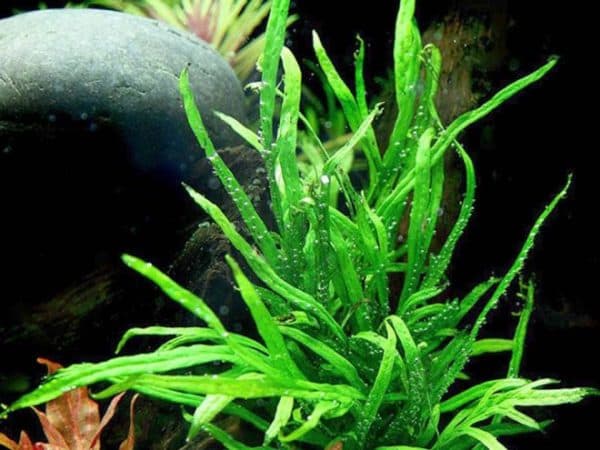

This culture, despite its unpretentiousness, with the right fit and reasonable care, looks very attractive and creates an effective design.
Species of spectacular ferns
These plants are not demanding to external conditions, they are able to adapt, and time has proven this. They have in common that the leaves have just begun to develop and represent a system of branches. Ferns of different species differ in color, shape of leaves and bush, rhizome.
Bolbitis (Bolbitis) of the Shchitovnikov family
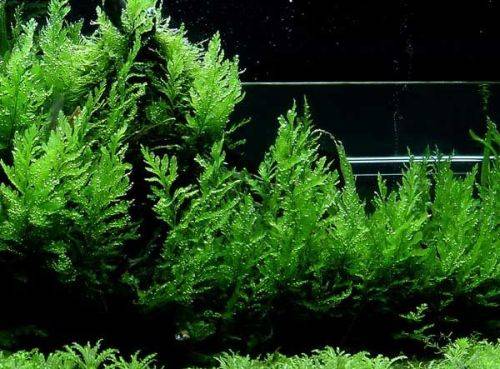

Bolbitis fern with a horizontally growing stem, due to which the leaf blades in the water take an unusual horizontal position, and waxy golden scales on the stems and leaf stalks have become a real decoration of aquariums. In length, it grows up to 60 cm, the stem can reach 1 cm, and the leaf width - up to 20 cm. The leaves are hard, pinnately complex, dark or neon green, slightly translucent in the light.
The formation of daughter shoots on the leaves is rare; for reproduction, the leaves are separated from the main bush. New plants are formed from them.
In order for the bolbitis to take root and grow well, the roots do not need to be immersed in the ground. To fix the fern, you can use a thread (elastic band), which can be used to attach the plant to a snag, a stone. In a new place, the bolbitis takes root slowly, it is better not to touch it unnecessarily. When acclimatized, it begins to grow well and grows into a bush of up to 30 leaves. Such a large plant can and should already be divided.
Azolla carolinian (Azolla caroliniana)
This fern refers to plants that do not develop in the depths of the water, but on the surface. Several floating azolls near them cover, like a carpet, a part of the water surface.
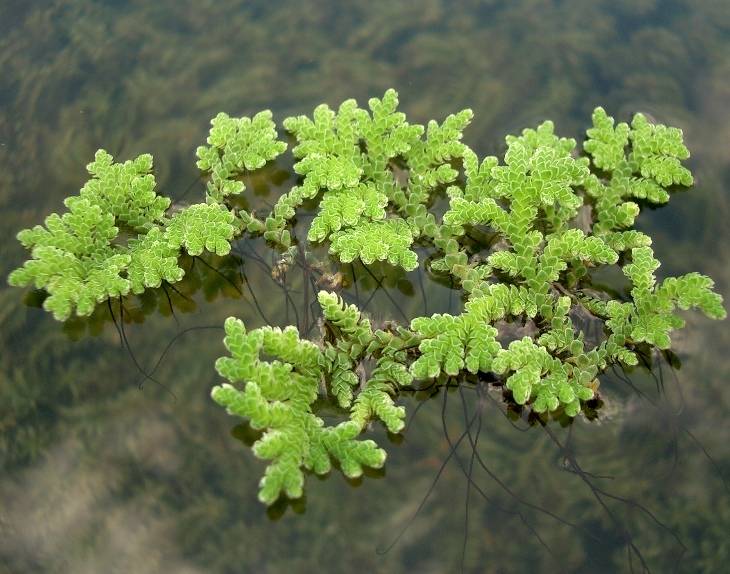

On the stem of the plant, attached one by one, there are delicate and brittle leaves. Those that are above the water acquire a greenish-bluish color, those immersed in water turn pinkish-green. The upper part of the leaf is massive - it feeds the stem, algae growing on the leaf promotes the absorption of oxygen and nitrogen. The lower, underwater, part of the leaf is thin, spores are attached to it.
The plant develops in the warm season, falls asleep in the winter. It is unpretentious, easily tolerates temperature fluctuations in the range of 20-28 ° C. When the temperature of the environment drops to 16 ° C, it stops growing and over time begins to die - it falls to the bottom, rots. In spring, viable spores give birth to new plants.
Ferns do not like dirty water in the aquarium, and you need to regularly renew the water in the tank. When caring for Azolla, you should monitor the level of hardness (water should not be hard) and light. Azolla needs 12 hours of light to develop.
If there are a lot of ferns, some of the floating green carpet can be removed.
You can save azolla in winter by placing part of the plant in a cool place (up to 12 ° C) in the fall, along with wet moss. In April, the saved fern must be returned to the aquarium.
Marsilea crenata
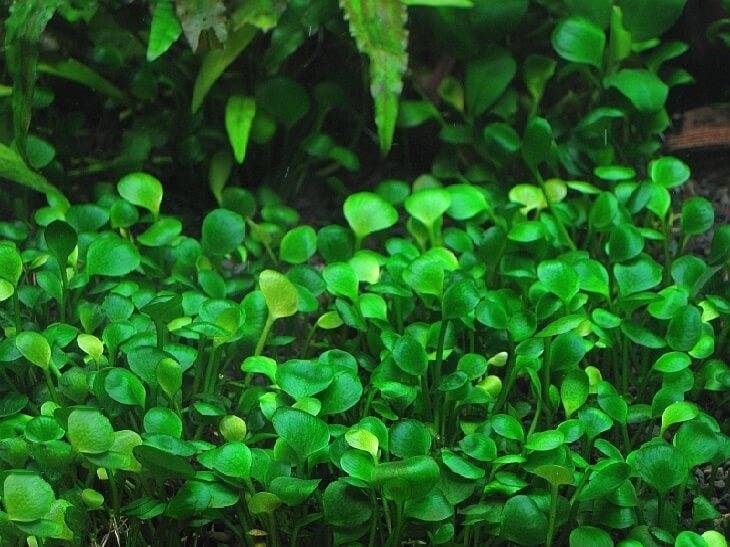

There are several popular types of Marsilia, one of them is krenata. The plant is planted in the soil. The stem with many small twigs on which leaves 5 mm to 3 cm in size grow, grows vertically. The twigs are close together, from 0.5 cm to 2 cm. Marsilia krenata in the aquarium looks bright thanks to the beautiful green color of the leaves.
The plant grows well fully submerged in water.
This type of marsilia is not whimsical to the hardness and acidity of the water, does not like bright light, but prefers medium and low illumination.
Marsilea hirsuta
This aquarium fern is native to Australia, but in natural conditions it can be found all over the world. Aquarists use it to create a beautiful foreground of the water container. The leaves of marsilia hirsut are clover-like; when planted in an aquatic environment, the shape of the quatrefoil, if the plant is not comfortable, changes. There can be 3.2 and even one leaf on the stalk.
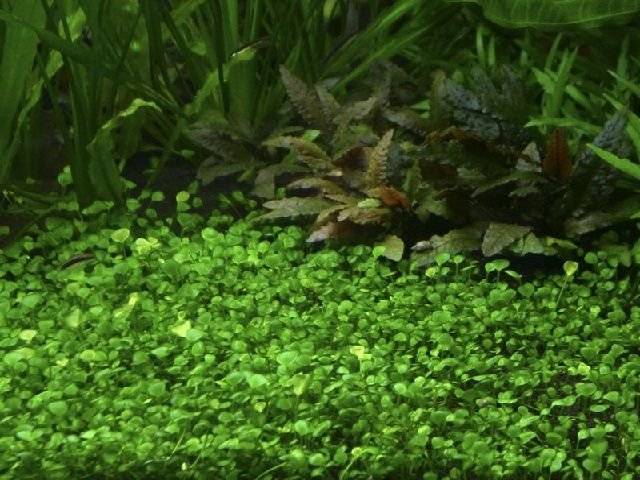

The rhizome of the plant spreads over the surface of the soil, together with it, fern leaves spread out in a green carpet. Marsilia hirsuta is planted in the ground with islands, separating groups of 3 leaves from the stem and deepening into the ground with tweezers. The root system of the new plant forms quickly, and the cobweb fern grows with yellowish young leaves, which then turn pleasantly green.
The plant loves good lighting, muddy soil, enough oxygen. When comfortable conditions are created, marsilia hirsuta spreads over the entire bottom of the aquarium.
From time to time, you can cut off the leaves on too long legs and level the entire surface of the fern thickets with scissors.
When even a haircut does not work, it is time to plant young plants. They take out the Marsilia carpet, choose the most promising groups from it and use them as seedlings.
Micranthemum sp. Monte Carlo
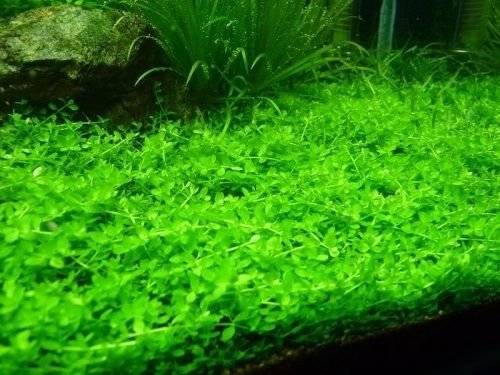

It may seem incredible, but aquarium ferns are still being discovered today. An unknown fern plant was discovered on the rivers of Argentina in 2010. It was registered as a Monte Carlo Micrantemum and began to gain popularity among aquarists. To do this, it has sufficiently large leaves that distinguish micrantemum from close analogs. In the ground, it is fixed so well that it is more appropriate to say it bites in and does not float to the surface.
When planting the Monte Carlo micrantemum, long roots should be cut and the seedlings should be scattered at a short distance from each other.
By combining different types of micrantemum, aquarists achieve original compositions. A smooth transition from small leaf ferns to large aquarium plants adds a special appeal.
Varieties of Thai fern
There are a number of varieties of the Thai fern, each with its own specific characteristics. All this should be taken into account without fail when choosing specimens for planting:
- Narrow-leaved "narrow"
A pretty plant with long, elongated leaf plates of a rich bright green hue. It is often used for aquarium design and due to its compact size it is suitable for decorating even small artificial ponds. It is characterized by slow growth.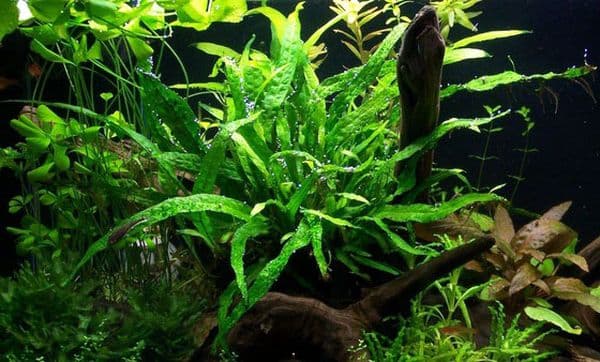

- Windelov
Artificially bred breeding variety. It is prized for its diminutiveness, because the height of adult specimens does not exceed 15 cm.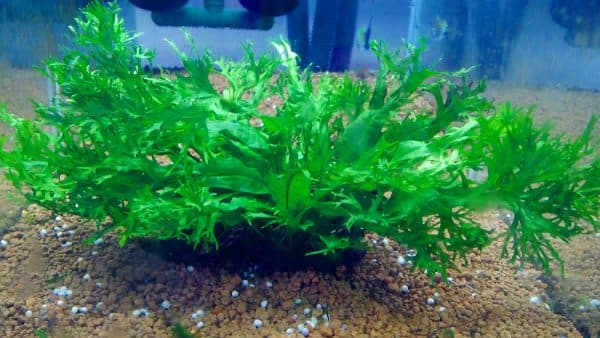

- Narrow-leaved "Narrow K"
Spectacular outwardly and unpretentious in the content of the fern. Good for creating beautiful aquarium designs.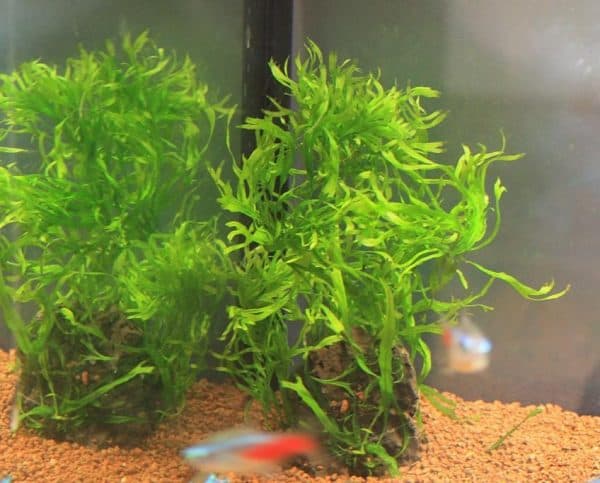

- How to plant correctly
Thai ferns grow well in any soil. For the full development and formation of a shrub, it is recommended to tie it to stones, snags.Since the aquatic plant performs a filtering function, many aquarists prefer to place it in the center of the reservoir for complete water purification. The aquarium can be of any size, but the plant takes root and looks best in deep and spacious containers.
Possible diseases
This aquatic culture does not have a real root system; the plant draws all trace elements directly from the water. If there is a lack of nitrogen or other elements, the growth of the Thai fern slows down, and some problems may also appear. Quite often, the leaf plates of this aquatic plant begin to turn black if the hardness of the aquatic environment increases, so beginners should regularly monitor and control the chemical composition of the water.
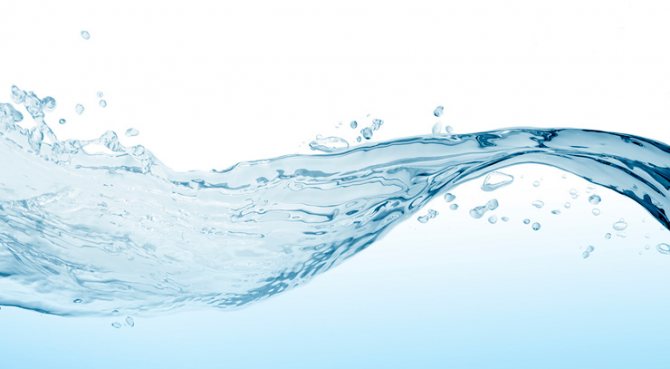

To prevent the occurrence of diseases in the Thai fern, you need to monitor the purity of the water.
In addition, some aquarium fish can damage the root system when they dig up the soil. Removing damaged areas of the fern quickly will encourage new foliage and roots to grow rapidly.
Compatible with aquarium inhabitants
The Thai fern is one of the few plants that are not dangerous to be close to goldfish. It is not recommended to plant it in an aquarium with such inhabitants as catfish, corridors, agamixis, which belong to the category of bottom fish and can damage the fragile, poorly developed rhizome of the plant.
Because of its toughness and bitterness, the Thai fern is not liked by herbivorous fish.
Therefore, it perfectly coexists with guppies, swordtails, scalars. Snails and a variety of molluscs are also not intimidating to the Thai fern.
As for other aquarium crops, ferns, due to their compact size, get along well with most plants, including light-loving ones. It neighbors well with tall and spreading shrubs, as it is resistant to shading.
The Thai fern is one of the most popular aquarium plants. Its benefits include attractive appearance, simplicity in everyday life, slow growth, shade resistance, as well as the ability to perform numerous useful functions, including filtration and natural cleansing. The large number of varieties allows each aquarist to choose the most suitable option for themselves in color, growth rate and size.
Reproduction
The method of cultivation of the Thai plant is vegetative, reproduction takes place with the help of small shoots - shoots that grow on mature leaves. The shoot is carefully separated from the main plant, and planted in a new place, securely fixing. The growth of a young shoot takes a couple of weeks, but at this time it is necessary to monitor the water parameters and take care of the future underwater inhabitant.
When purchasing seedlings in stores, experienced aquarists recommend carefully examining them for rot, broken roots and other abnormalities before buying. The future growth and health of the fern depends on the condition of the shoot. Do not forget that along with the acquired plant, harmful organisms can be introduced into the aquarium, so such caution will be useful.
The Thai fern is an attractive aquarium plant that will be a real salvation for herbivorous fish owners. But in other reservoirs, the microzorium will be useful - it will decorate the underwater space, and will serve as a shelter for fry.
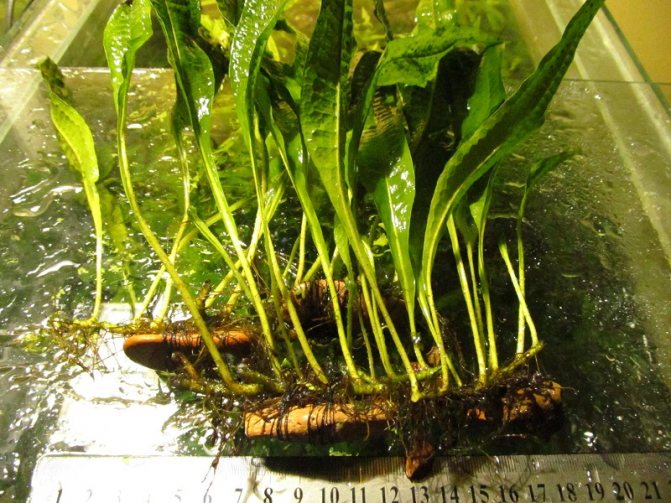

Aquarium ferns: types
Modern aquarists prefer tropical ferns for arranging the decoration of their home pond. This is due to its beautiful appearance and resistance to increased moisture.
Indian water fern
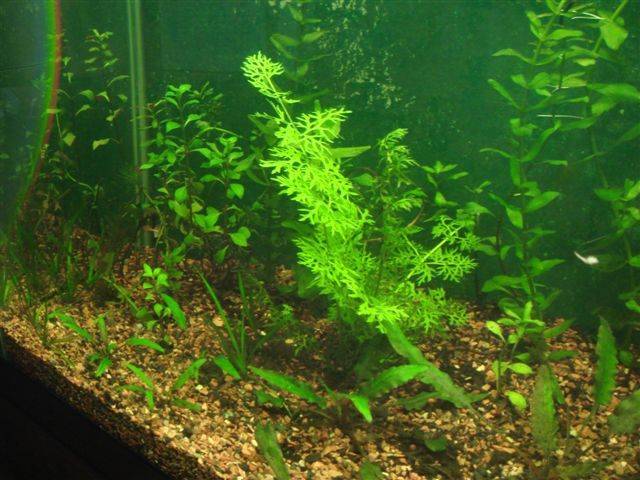

Indian water fern
It was first discovered in Asia. Today it can be seen in many countries: South America, Australia, Africa. When this fern is young, it is not planted in the ground. It freely settles on the water surface, and lives there until several additional leaves appear on it.
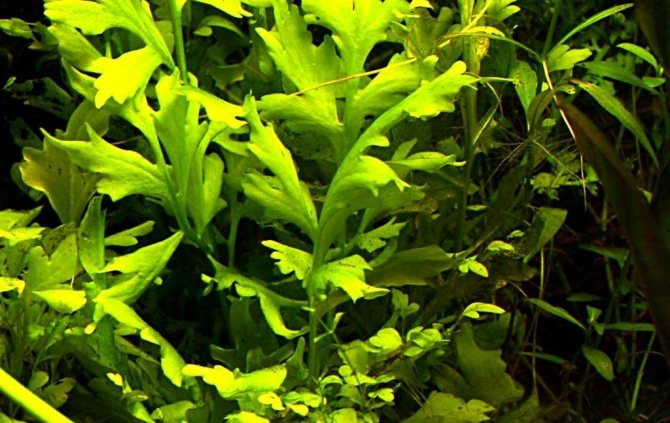

Pterygoid Indian fern (kale)
Watch a video about Indian fern:
Thailand fern
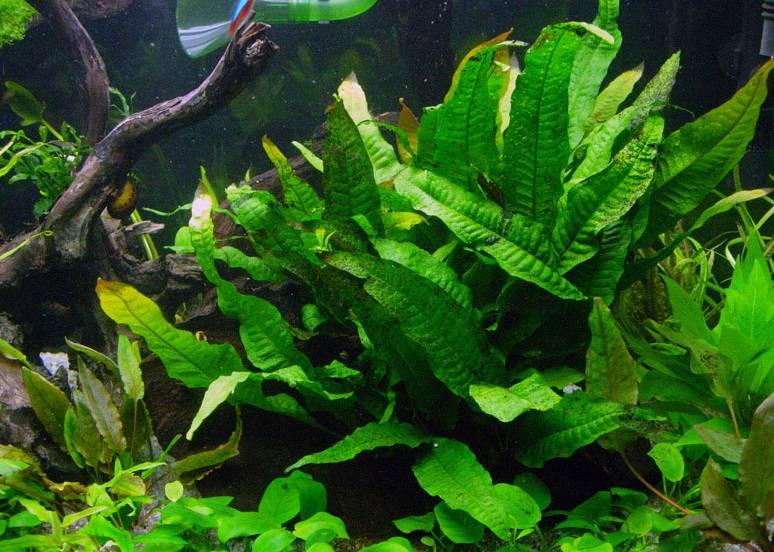

Thailand fern
From the very name of the Thai fern, it is clear that its origin came from Thailand. This type of fern plant differs from the previous species by the presence of many legs. Its daughter leaves develop on a single creeping root system, but are separately living algae.
The horn fern is found in the Madagascar Islands and African wetlands. Its peculiarity is an unusually beautiful leaf shape, similar to a wide feather.
Thai fern video:
Shield or fern Bolbitis
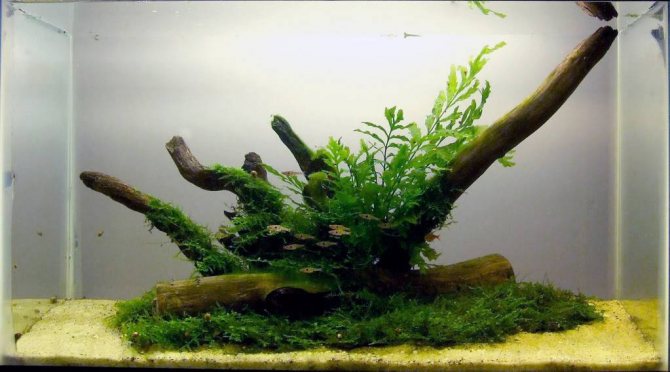

Bolbitis fern on snag
This is a unique plant and the only one with such characteristics: it differs from its counterparts by the stem, which does not have an upright position, but is located on the aquarium substrate. Also on its petioles and stems there are waxy scales of a golden color.
In addition to these varieties, there are many more less popular fern options, for example:
- ceratopteris;
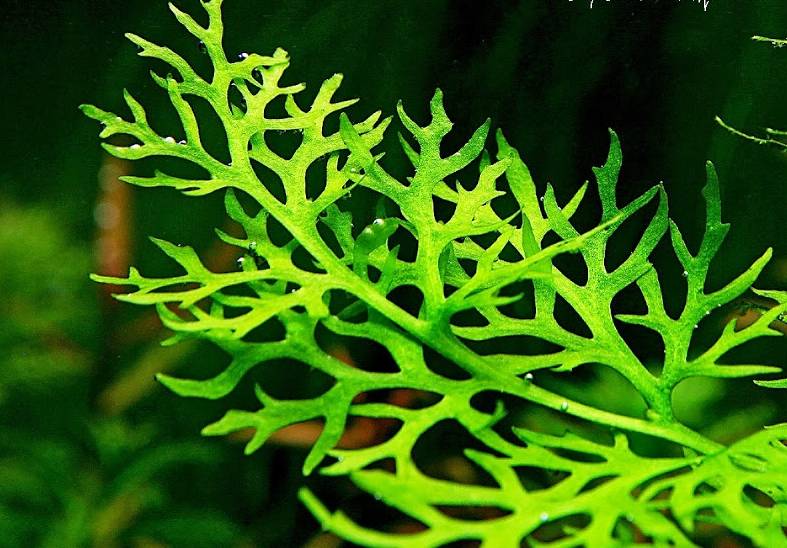

Ceratopteris
- Marsilia;
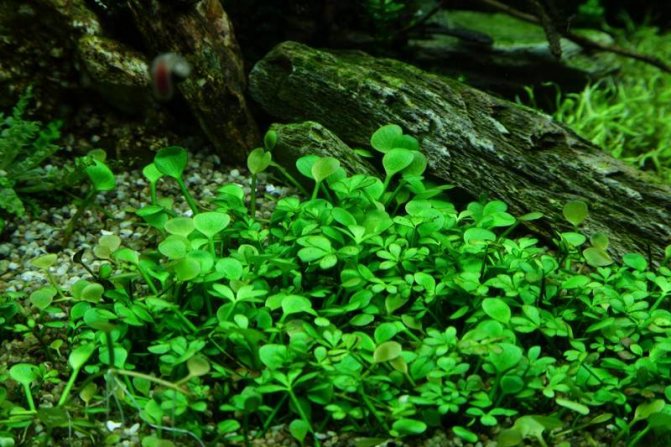

Fern Marsilia in the aquarium
However, it is impossible to determine from the description which one is more suitable for your own aquarium. In this case, it is recommended to observe these algae living in the store aquarium space.
After acquiring such vegetation, you will definitely need to create comfortable living conditions for it.
Additional facts
When purchasing a fern for planting in an aquarium, you should also know some information about it:
It is best to plant Indian fern bushes one at a time, closer to the center. This will be useful, since the plant actively absorbs various organic substances that are inevitably formed during the life of the inhabitants of the aquarium. So, the fern becomes an assimilator of these substances, allowing you to maintain the purity of the water. The fern is unique in that it does not die in the absence of frequent water changes. On the contrary, it is a source of essential nutrients for him.
Reproduction of the plant occurs due to the appearance of daughter branches on the old leaves of the main bush. First, several leaves are formed, then small lobes of the roots. They separate from the mother bush and remain on the surface of the water, where they can calmly grow as a floating species. In case you want to use it as an underwater plant, the bush is planted in the ground.
Indian fern, with proper care, will decorate any aquarium or aquatic greenhouse. It is charming and simple, and thanks to its branched leaves it gives the whole water space lightness and volume. The conditions of its maintenance are not too troublesome, they are within the power of even a novice aquarist. A little effort and attention, and a bright representative of some of the most ancient plants, with a history of several hundred million years, will appear in your underwater corner!
Back to content
How to fix on a stone or snag?
This procedure can be done in various ways. All of them are quite practical and suitable for every person, since the materials at hand are used to fix the plant, which are in every modern apartment.
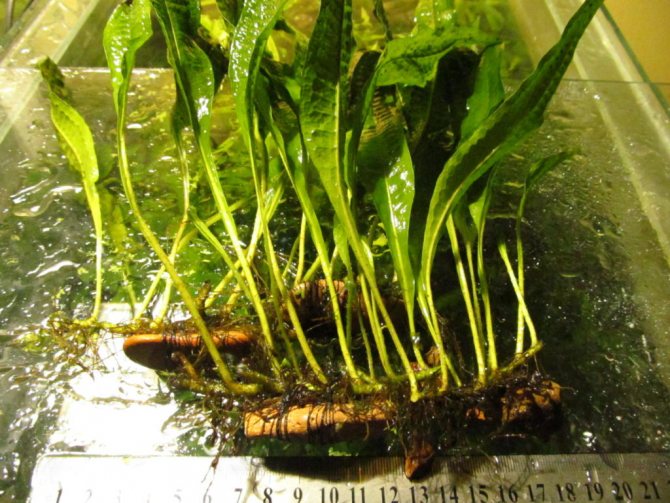

Actually, you can attach a fern as follows:
Fishing line. It is in every house where a fisherman lives. But if not, then it can be purchased at any specialty store, and it is not expensive at all. The advantage of the fishing line is that it does not dissolve in water and looks imperceptible if you do not wind too much. But when tying a bush, you need to be careful, since you can easily cut a leaf or stem with a fishing line. Accordingly, it is not necessary to tighten too much;
Thread. The ideal option is nylon, since this material is excellent against water and is generally very reliable. If not, then ordinary cotton threads will do. But their disadvantage is that over time they can dissolve in water. Therefore, the fern should be wrapped well, "conscientiously". Especially if the aquarium is inhabited by ancistrus and other similar fish that like to “explore” everything;
Wire... Best suited are those small cuts that are used to wrap new headphones and other wires (for example, when buying a computer, mouse, keyboard, etc.). They do not affect the water in any way and are very easy to handle. Tying ferns with thread is very inconvenient if you do it right in the aquarium, and not in the room. In this sense, the wire wins significantly. We apply the bush to the branch, wrap it with a piece of wire and spirally twist it from behind, gradually tightening it so that the plant does not dangle;
Moment glue. It is important that it is of high quality and water resistant. A few drops on the roots are enough and press them to the stone. They, of course, will die off, but by that time the Thai fern will get stronger and will be able to catch on on its own.
Where it grows in its natural environment
The Indian fern prefers warm tropical locations. It is ubiquitous in water bodies in Asia, South America and Australia. Favorable areas for him are marshy places with excess moisture. Therefore, when buying this type of fern, it is worth considering that the plant loves heat very much. Therefore, the environment in which it will be placed should be as close to natural as possible.
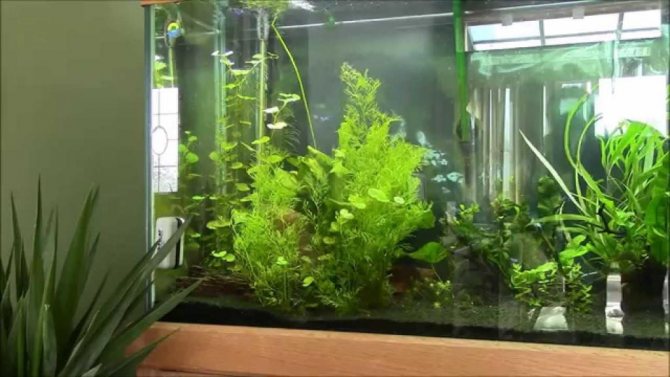

Where does it grow
We have already mentioned that this plant originally grows in tropical climatic zones, but let's add specifics. This includes Asia, Australia, South America. You can stumble upon a fern in a swampy and lighted place with a high level of humidity. By the way, he became so popular because of his ability to adapt to a variety of conditions.
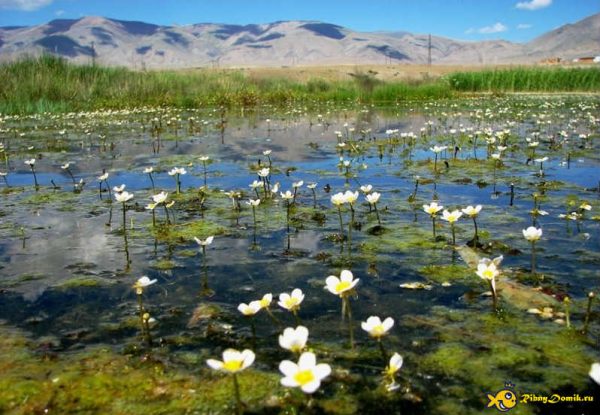

Role for the aquarium
In the aquarium, the Indian water fern performs an important function of water purification. It absorbs the substances contained in the water, therefore, in the case of purchase for this purpose, the correct location is chosen.Then the fern will fulfill its purpose more efficiently.
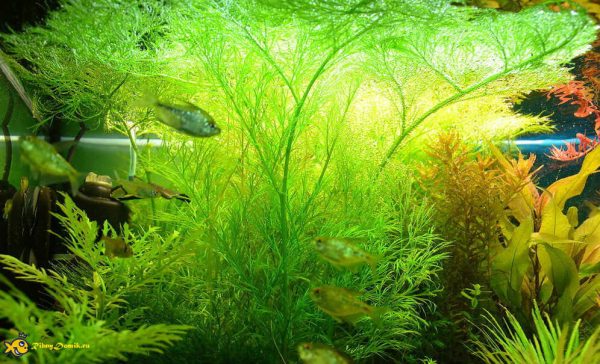

Correct care
Indian fern is not whimsical by nature, but following the recommendations, you can achieve an amazing result. Some people who are savvy in matters of content can grow up to fifty centimeters in height. Here are the tips:
- It should be borne in mind that the root system of the Indian fern is fragile. This is a key question when choosing a soil. We recommend stopping on something soft so as not to damage the roots. Sand is perfect. If we talk about the thickness, then it is usually about four centimeters.
- For growth, the water temperature must remain at twenty degrees. The optimum temperature is twenty-five degrees.
- When this plant is planted, do not forget about the lighting. There are two options here: allocate a place in the house for it that is well lit by sunlight, or use fluorescent lamps to create artificial lighting. The lamp must have a certain set of parameters, so its choice must be taken responsibly.
- When exposed to direct sunlight, the water can bloom, so natural lighting implies light scattering. Such a precautionary measure will protect the plant from possible harmful effects.
- The problems with this plant cannot be related to disease. They are attributed to inadequate care. Such a state cannot be triggered - the plant will get worse, it may even die.
This fern gets along well with most aquarium dwellers, but being close to other plants can negatively affect the roots, which can intertwine with each other.
General description and properties
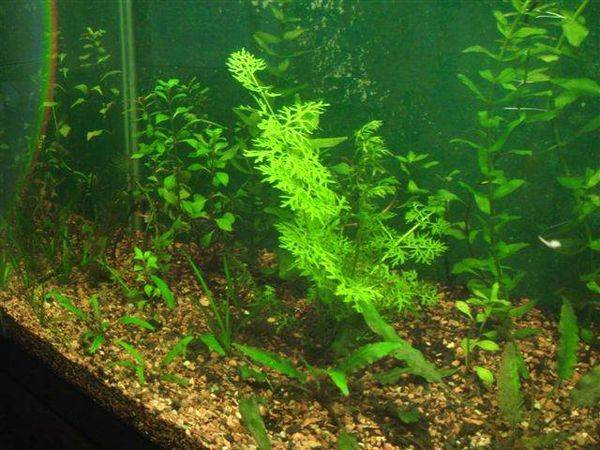

The water Indian fern is an inhabitant of the tropics. It grows in wet, humid places where the sun's rays provide enough warmth and light. This variety, like all ferns, feels great even in not the most comfortable conditions. It is no coincidence that it is popular for keeping aquariums.
The water fern not only looks peculiar and pretty, but is also quite hardy and unpretentious. If you follow all the conditions for its maintenance, it can reach half a meter in height. Interestingly, the color of this plant depends on the mineral content of the water in the aquarium. It ranges from pale green or emerald blue to deep green. The overgrown fern looks like a lush bush.
Hydrophyte not only serves as an original design element. Indian water fern is used for cleaning aquariums. He absorbs substances in the water, and he does not care whether they are useful or harmful. So that the water in the aquarium will always be purified. The plant should be centered.
Bolbitis Gedelota or Bolbitis Heudelo (Bolbitis heudelotii)
The third most frequently grown group of ferns in aquariums is the Bolbitis genus common on the African continent, more precisely, the only truly aquatic species - Bolbitis Gedelota (Bolbitis Hedelo). It is a stiff-leaved, slow-growing, shade-loving fern, characterized by negative buoyancy: its tissues are so dense that this plant drowns in water and sinks to the bottom. Like microorum, it has a long horizontal rhizome, from which fronds grow upward. But that's where the similarities end. Bolbitis is more demanding on temperature than the previous species: it grows normally and develops at 22-28 °. At 20 ° C, bolbitis stops growth, and at 30 ° C, it is depleted and degraded.
It is better to place the bolbitis in the background, on the sides of the aquarium, in the darkest corners. The black tough rhizome of this fern can be fixed on a stone or driftwood, or you can simply place it at the bottom behind the driftwood. It is impossible to immerse the rhizome and rhizoids in the ground, in order to avoid decay.Bolbitis grows even more slowly than microorum, releasing one very rugged form of dark green leaf on a long petiole in 1-1.5 months. Young leaves are twisted into a spiral, like those of a forest bracken fern, which then slowly and beautifully unwinds into a full-fledged frond.
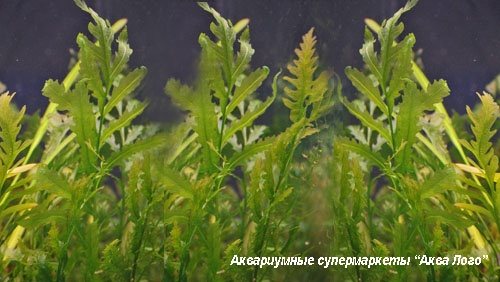

Just like other ferns, Bolbitis does not like hard and alkaline water. It is best to keep it in an old aquarium with acidic soft water, if possible without or with minimal water changes. Better to add osmotic water or distillate. Of all the ferns, Bolbitis is the most shade-loving. In bright light, it quickly becomes covered with harmful algae and dies, but it is able to endure almost complete darkness for a long time. Unlike the previously described species, the bolbitis is not afraid of the flow, so it can be placed close to the filter. If ceratopteris and microorum do not need additional supply of CO2, then Bolbitis, in contrast to them, reacts very positively to it, increasing the growth rate and forming more beautiful leaves.
Bolbitis propagates by dividing the rhizome. Children on leaves, unlike Indian and Thai ferns, do not form bolbitis under normal conditions.
Bolbitis on a snag Bolbitis Hedelo Bolbitis Hedelo on a snag
Sometimes it is sold as an aquarium plant and the second type of bolbitis - Bolbitis heteroclita... It is distinguished by weakly dissected or unsected leaf plates with a long sharp tip, most often of a three-lobed shape. This second type of bolbitis is very capricious and difficult to maintain. If Bolbitis Gedelota is a purely aquatic plant that almost never forms aerial leaves, then Bolbitis heteroclite, in contrast, is an emergent plant, almost terrestrial. In a submerged aquarium, it can be kept for no more than six months, after which it needs a long rest in a paludarium or greenhouse. In aquarium design, this whimsical fern is sometimes used to decorate the tops of rocks or driftwood located at the very surface of the water. In this case, its rhizome is located under water, and the leaves rise above it. But working with this moody species requires considerable skill, so it should not be recommended for less experienced aquarists.
Use as decoration
The Thai fern is an excellent decoration for the underwater kingdom. The home aquarium is significantly transformed, the plant fills the container with its bright bushes. The Thai fern allows you to create a variety of compositions of stones and underwater objects, forming green gardens in a short time. It literally brings the aquarium to life, perfectly complementing an underwater snag or a fish house.
On its foliage, stems, small species of fish can throw caviar. Viviparous individuals can safely retire in the thickets of the plant, and the weak ones can hide from aggressive neighbors. The fern creates a cozy, peaceful environment, ennobles the territory, does not require special care.
Aqua design
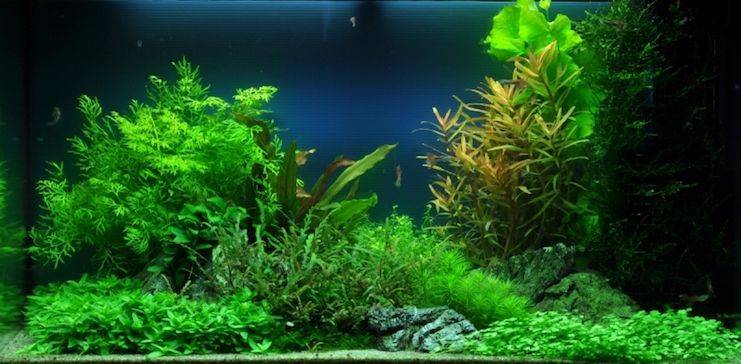

Ceratopteris thalictroides is ideal for quickly filling an empty aquarium. But at the same time, you need to carefully monitor so that other plants do not suffer, since the Indian fern will displace them, in order to get all the space. Many aquarium fish like to spend time hiding in the green of this beautiful plant. But, but aquarium snails like its taste, several snails can eat a whole bush in 2-3 days, so you need to control this too. If conditions are favorable, the eaten branches will grow back quickly. In about 3 weeks, several fern bushes can fill a 100 liter aquarium.
This is not a whimsical enough plant, suitable for growing both professional aquarists and beginners.
Types of Thai ferns
Ferns love warm and humid environments, and many aquarium ferns are native to Thailand.
Thai narrow-leaved (Microsorum pteropus "Narrow")
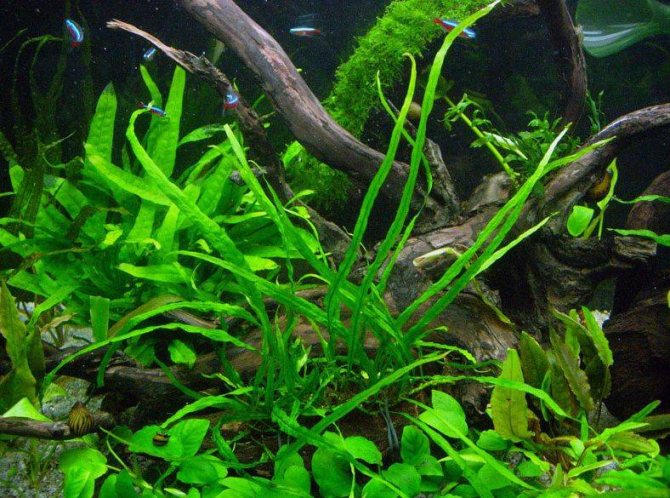

Microzorium resembles a bush, consisting of long stems and leaves. The stems, covered with small villi, are the root system of a fern-like plant. The stems do not penetrate deep into the ground, but spread out. Therefore, it does not matter for the microzorium whether the soil is with stones or not.
When cultivating microzorium, it is not necessary to trample the roots into the soil. The seedling is simply laid on the bottom and pressed down with a pebble so that it does not rise to the surface.
Microzorium is planted in large and small aquariums, along the perimeter and in the middle. If the container with water is large - in groups.
In the home reservoir, the Thai narrow-leaved fern looks spectacular. To maintain the leaves in an aesthetic form and preserve their bright greenery, the plant must be provided with bright light.
This variety does not like hard water, it gets sick and becomes covered with black spots. The comfortable temperature for her is + 24 ° C; at lower values, the plant inhibits its development.
Thai Windelov (Microsorum Pteropus "Windelov")
This type of aquarium fern is distinguished by the leaves branching at the top, like antlers. Thanks to the branching, the bush acquires splendor and an original look, for which aquarists like it. The height of the leaves of an adult plant reaches 30 cm, a little more than 5 cm wide. The leaves are green, from olive to rich green, color.
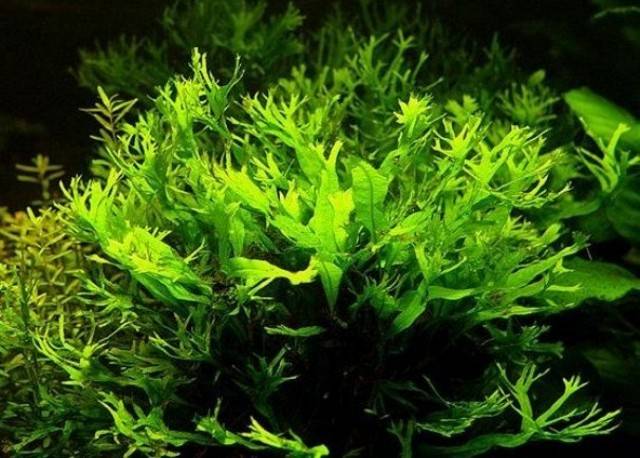

Vindelov has a weak root system, with it the plant clings to stones, driftwood and so fixes the position. If Vindelov's fern rises to the surface, then not for long. Under its own weight, it will still go under the water.
It is not worth introducing the Thai Vindelov rhizome into the soil, it will rot there.
It is not demanding in care, it grows well in fresh and brackish water. Forming slowly.
Video
Indian water fern (Ceratopteris thalictroides)
Indian fern in the aquarium, maintenance, photos, care. Aquarium plants for beginners.
pet shop AMPHIBIA Tambov (Indian fern)
Indian water fern Ceratopteris thalictroides
Indian fern (Ceratopteris thalictroides)
Hello dear aquarists! Today I would like to tell you about a very popular and interesting aquarium plant, which is known as the Indian fern, or Ceratopteris thalictroides. This aquarium plant belongs to the horn-like family and it is distributed in the tropical regions of our planet.
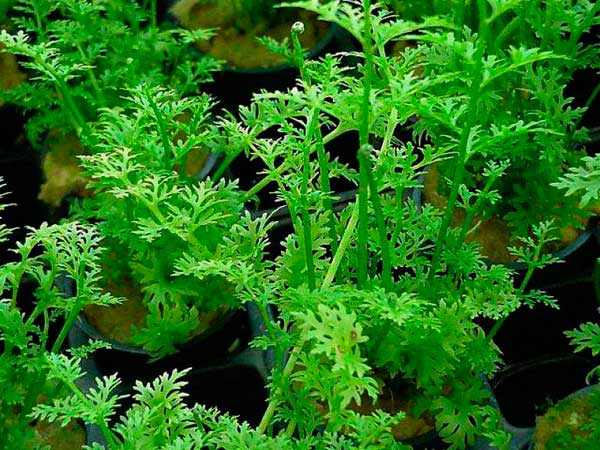

The Indian fern has been in great demand among aquarists of all stripes for a long time. Its leaves are beautiful and finely dissected, the color is light green. Under good conditions in the aquarium, the hydrophyte can reach half a meter in height. In hobbyist aquariums, most often you can find varieties of fern, in which the leaves are less dissected. It is also known as the horn fern or Ceratopteris thalictroides cornuta. The content of various types of ceratopteris is virtually the same.
A tropical aquarium with a water temperature of 22 to 26 degrees is suitable for keeping the plant. At an aquatic temperature below 20 degrees, growth slows down significantly and the leaves begin to shrink in size. Water hardness must be low, maximum 6 dH, and the active reaction of the medium must be at a neutral or slightly acidic level. The fern does not need constant water changes; it feels great in old water saturated with high concentrations of humic acids.
But the lighting for the hydrophyte needs very strong. You can use both natural and artificial. But it is highly undesirable that direct sunlight falls on the aquarium, otherwise you will not end up with problems with water blooming. You can read about the fight against algae and their classification in this article. The duration of daylight hours should be at least 12 hours.


The Indian fern has a developed root system, but the roots themselves are quite brittle and tender. Accordingly, the aquarium substrate should be of a fine fraction and its siltation should be strong enough. The ideal substrate for hydrophytes is coarse river sand. The thickness of the aquarium soil layer should be within 4-5 centimeters.
Indian fern does not need additional mineral feeding; on the contrary, it is extremely sensitive to excess organic compounds in aquarium water. The food that it receives from water and soil is quite enough for the grass.
Ceratopteris multiplies very easily and simply. The mother plant forms daughter plants on the old leaves of the main plant. As soon as several leaves and root lobes have formed on the daughter plant, it breaks off from the mother bush and floats to the surface. It can grow in the same form and in a floating form. In addition to this form, aquarists sometimes have a form with large-festooned leaves. It is sometimes called "kale" and is referred to as the subspecies Ceratotpteris cornuta. It must be grown floating, and the conditions of detention do not differ in any way from those described above.
Ceratopteris thalictroides
Horny family - Ceratopteridaceae.
Distributed in tropical areas around the globe.
One of the most popular plants for aquarists. It has beautiful finely dissected light green leaves, which in an aquarium, under favorable conditions, reach a height of 40-50 cm. Most often, aquarists have a fern variety with less dissected leaves, called the horn-shaped fern (Ceratopteris thalictroides cornuta). The conditions for keeping ceratopteris with different leaf shapes are the same.
The plant is most suitable for keeping in a tropical aquarium at a temperature of 22-26 ° C. At temperatures below 20 ° C, its growth slows down significantly, and the leaves become small.
Water must be soft - hardness no more than 6 °, with a neutral or slightly acidic reaction. In hard water with an alkaline reaction, the plant degrades. A constant water change is not needed, the fern grows well in old water with a high content of humic acids.
Strong enough lighting is required. Both natural and artificial light are allowed. The plant should be shaded from direct sunlight. For artificial lighting, fluorescent lamps of the LB type can be used, the power of which should be 0.4-0.5 W per 1 liter of volume, or incandescent lamps, three times more powerful. The duration of daylight hours is at least 12 hours.
The root system of the plant is well developed, but its roots are tender and brittle. Therefore, the soil should be composed of small particles and be well silted. Coarse sand is most suitable as a substrate. The soil can be laid in a layer up to 4-5 cm thick.
This fern does not need special mineral feeding, on the contrary, it is very sensitive to an excess of mineral substances. The plant has enough nutrition obtained from soil and water.
The fern reproduces easily and in an original way, by the formation of daughter plants on the old leaves of the mother bush. After the formation of several leaves and a root lobe, the daughter plant breaks off and floats to the surface of the water. There it can grow like floating. It can also be planted in the ground.
In addition to this fern, aquarists have another plant similar to it, which has large-festooned leaves. It is often referred to as "kale" and belongs to the species Ceratopteris cornuta.
Difficulty in content
The species ceratopteris thalictroides has no particular difficulties in keeping. The main thing is to provide him with the right light in sufficient quantity and provide a comfortable soil for his delicate root system.If the temperature balance is not observed, the fern will still grow, albeit not so intensively.
Keeping in the aquarium
Priming. The fern has a strong root system, but the roots are very fragile in structure. Choose a soft soil, preferably covered with silt (peat, small pebbles, sand). For an average plant, the soil thickness should be at least 4 centimeters. You can plant individual bushes in different pots filled with soil.
Water parameters. The optimum temperature for keeping a fern should be approximately 25 ° C. If the temperature is lower (at least 20 ° C), the plant will not die, but its growth will slow down. It is recommended to defend the water, since the fern will not survive in an acidic alkaline environment, which is usually observed in running water purified with chlorinated substances. Ideally, the water hardness should not exceed 6 degrees.
Not recommended change the water in the aquarium too often, ferns are comfortable in old water rich in humic acids. Fern chemicals - death.
The dimensions of the aquarium. The size is selected depending on your preference. If you plan to grow a fern taller than 40 centimeters, then the aquarium should accordingly be slightly larger than the plant. The plant is rarely more than 30 cm wide. Choose the length of the aquarium in accordance with the number of bushes (one bush per 20 square centimeters).
Lighting. Fern requires a lot of light to grow normally. He will be satisfied with both sunlight and lamp. Under artificial lighting, fluorescent lamps with a power of up to 0.5 W per liter of volume or incandescent lamps with a power of not more than 2 W per liter of volume are used.
IMPORTANT! If you choose natural lighting, be sure to diffuse the sunlight, as direct rays can damage the plant. The fern requires 10-12 hours of light a day.
Aeration and filtration. The Indian water fern is itself a "filter" for the aquarium. Therefore, he does not need an extra helper, he lives well in old water, which he himself purifies. But oxygen can be added to the water for additional growth.
Compatible with other inhabitants in the aquarium
This species gets along well with small breeds of aquarium fish, which hide with pleasure in its dense foliage. If the aquarium contains fish species that like to dig and dig into the soil, the plant must be planted in a small container so that its root system does not suffer from other inhabitants. The fern is ideal for breeding labyrinth fish (cockerels, gourami). It is not advisable to plant with other plants in order to avoid intertwining root systems.
Diseases, their treatment and prevention
Indian fern cannot have specific diseases. All deviations from the norm in development are caused exclusively by improper care of the plant. Chemical water, burning sun rays and aquarium inhabitants who are not averse to feasting on leaves - all this gradually leads to the death of the plant or an obvious deterioration in its condition (small or yellow leaves, poor budding, extremely slow growth, drying out of the root system).
Life span
With proper care, such plants can delight you constantly, giving new shoots.
Average price and where can you buy
One Indian fern bush costs about 300 rubles. You can buy it at pet stores that have a section for aquarists.
Diseases and pests
The pests of the Thai fern are bottom fish that like to dig into the soil. It is advisable to systematically carefully remove the areas damaged by them, for a new growth of the aquatic plant.
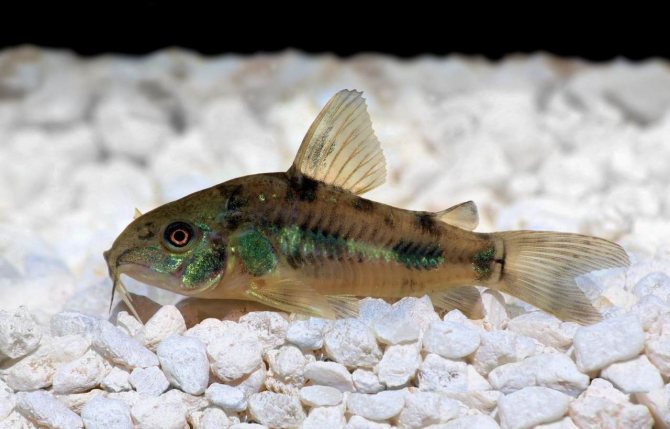

Bottom fish
Far Eastern bracken fern: description, planting and care
It is undesirable for the fern to coexist with the following species of fish: changeable corridor, catfish, agamixis.Ideal for: guppies, anubias, apistograms, scalars, swordtails.
Improper care can harm the fern: lighting - will burn the leaves, affect their color, hard and acidic water - completely ruin the foliage, stop the process of reproduction and growth.
For your information. In order to prevent diseases, the plant should be properly taken care of.
Main types
Pterygoid
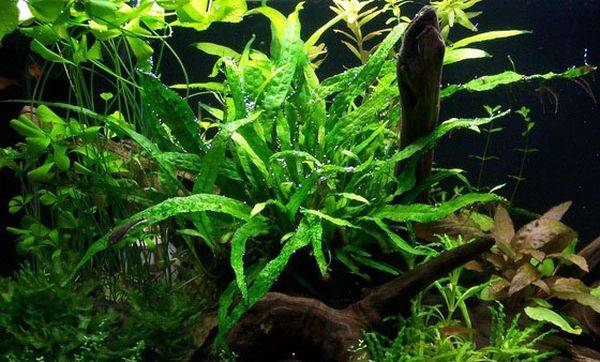

This type of hydrophyte has more solid leaf plates, it is also called "water cabbage".
Lace
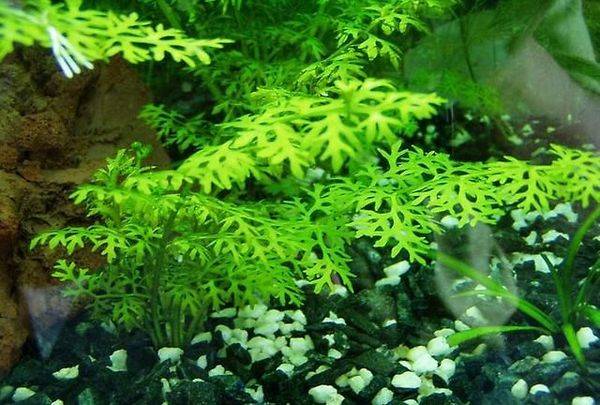

The lace look lives up to its name. It has elongated, elaborately cut leaf plates that generally create the effect of a lacy surface.
Thailand
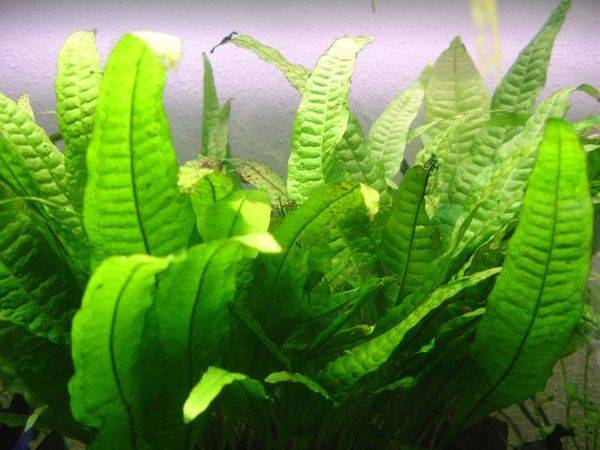

The Thai type of hydrophyte differs in that it has not one, but several interconnected root systems.
Shchitovnikovy
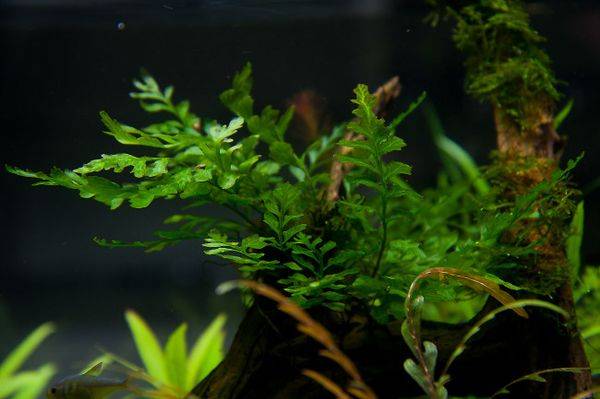

A variety that is equipped with gold-colored scales. The main feature of this hydrophyte is horizontal growth. It does not grow upward, like all the plants that we talked about earlier, but in width.
Fern care
Features of the content
Fern plants have conquered many aquascapers with their unpretentiousness. Unlike many fish and plants, they are less demanding on water purity, so they feel much better in habitable water than in new water. To breed this type of algae, you should change the aquarium liquid as rarely as possible. In this case, you should not do a 50% substitution, ¼ is enough.
Water requirements and feeding
However, the plant makes demands on the very water parameters of the aquarium space. For a good fern development, the necessary water of a soft, slightly acidic or neutral composition. If the aquarist has a desire or need to increase the growth of the fern, then a urea supplement should be added (it is freely available in a specialized store). Compliance with the aquarium temperature should be + 20-24 ℃, which is quite consistent with the parameters that are required by most fish.
Lighting
Ferns are light-loving plants, so lighting a home pond will allow them to grow and develop well. Of course, if they live in a shaded space, they will not die, but if they stay in an uncomfortable environment for a long time, the plant will begin to wither and hurt. It is recommended to create a daylight for them, at least 12 hours, even in the winter time period. To do this, you can install a fluorescent lamp near the aquarium space.
Anchoring in soil
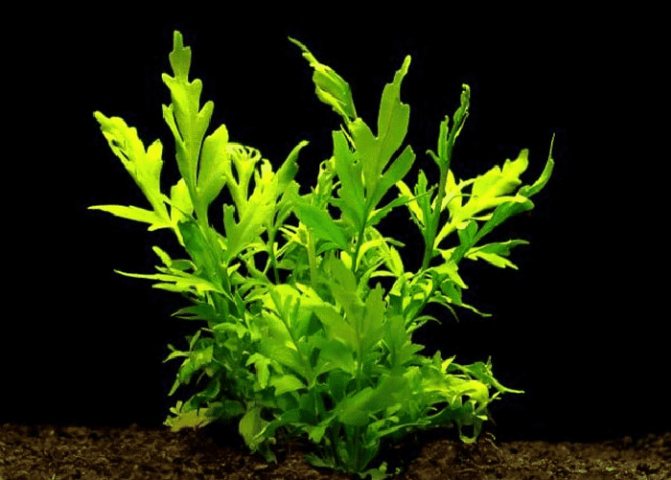

Rooting a fern won't make it difficult even for a novice aquarist. The plant is not demanding on the substrate, so replacing it before planting the plant is not required. However, it is recommended to place pebbles there (in case the soil is sandy). They are required so that the fern can gain a foothold in the soil for the first period of time, and then the vegetation will adapt and adapt to the new habitat.
Cohabitation
Plants of the fern variety get along well with calm, peaceful fish, hiding behind their leaves and not damaging them. In relation to other algae, it is best to avoid planting together to avoid intertwining the leaves.
A feature of ferns is the cleansing of the aquarium space from harmful components that affect other aquatic inhabitants.
However, such an exotic plant can also absorb nutrients, but this is less dangerous for the fish surrounding it.
Fern diseases were not found. Improper care can be the only cause of the disease. You should be careful with feeding, its excess can affect the plant not only for the better, but also for the worse.
Reproduction, general data
Fern plants reproduce vegetatively, and they can independently separate the daughter leaves that will float on the surface of the water.They will be located there until small roots appear on them, after which the young ferns will sink to the bottom and catch on the ground. It is recommended to notice the appearance of the root system before they take root in the substrate, then you should move them to another habitat.
Reproduction and growth
If comfortable conditions are created for the vegetation, then the spore fern will multiply day and night. The stem height of vegetation can reach 60 cm inside a domestic reservoir. If the fern plant grows too much, it will need to be dismembered and disposed of from the general aquarium. To do this, you can use various points of sale, make a gift to relatives (friends) for a holiday or transplant it into another aquarium.
Despite the unpretentiousness of the fern variety, you should not interfere with its natural development. This can backfire.
It is highly recommended: to transplant and relocate this plant as little as possible.
When planting a plant from the fern family in your own home reservoir, it is advisable not to disturb its peace, and to be careful with intensive filtration, fish catching, water blowing, so as not to disturb their peace. Also, this plant is categorically not suitable for fish burrowing into silt (for example, aquatic inhabitants of the carp family), because they are able to dig up a plant.
What is
A wide stem, from which thin branches branch off, predominantly light green and dark green. This aquarium plant has a developed root system, it grows in tropical climatic zones, and the main feature is an amazing way of reproduction. With proper care, a bush can grow from one tiny leaf. This trait ensures survival and explains how it has survived to our times.
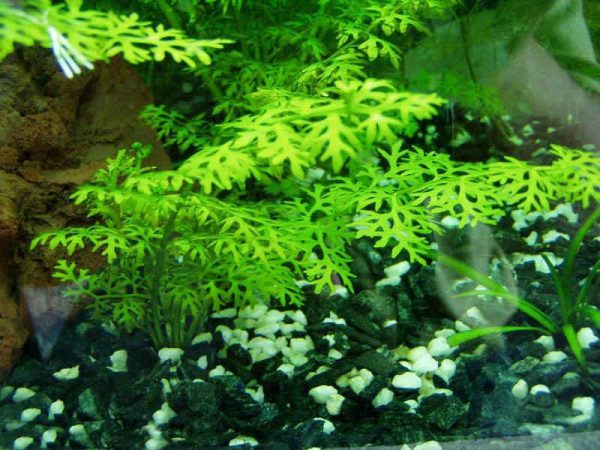

Benefits for the aquarium
The fern is used to form a habitat that is convenient for aquatic inhabitants - they feel the most protected in an aquarium with vegetation. And a reservoir with dense thickets looks much more beautiful than one in which there is no greenery. Aquarium owners experience the aesthetic pleasure of contemplating the "underwater jungle", and the fish receive additional oxygen.
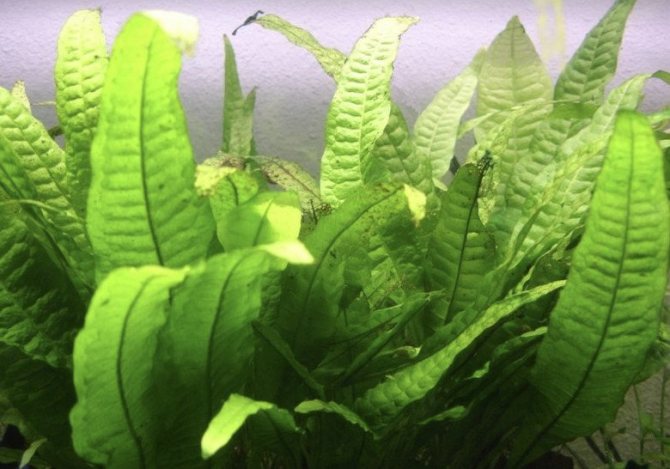

Also, this plant cleans water, draws in harmful elements.

